










By Jim Tremayne
Atlantic City, N.J. – Once again, DJX brought the DJ world to Atlantic City and delivered a winning hand.
Held this past Aug. 5-8 at the Hard Rock Hotel & Casino on AC’s legendary Boardwalk, DJX – the DJ industry’s longest-running trade show/exhibition –completed its 38th event since its 1990 incarnation. Produced by DJ LIFE and Hazan Media Group, DJX presented its unique combo of DJ-related technology exhibits, educational seminars, and sponsored After Dark parties.

The Numbers: DJX’24 featured 97 exhibiting brands and enjoyed a 7-percent increase in attendance from the 2023 show. The DJX’24 showfloor was 9-percent larger than the previous year’s floor. The show had a 15-percent increase in paid all-access passes from the previous show. DJX’24 had attendees from 41 of the 50 United States and from 12 different countries.
The Show: DJX’24 delivered a packed schedule of exhibits, seminars, and sponsored parties. The show saw participation from exhibitor/sponsors like AlphaTheta, QSC, DAS Audio, Electro-Voice, Chauvet DJ, RCF USA, Technics, Mixed In Key, DJ.Studio, Mixware, Odyssey, Carnival Cruise Lines, The Knot/ WeddingPro, Vibo, SMPL, JetPack, JMAZ Lighting, Glowtronics, and American Music and Sound (including Hercules, Reloop, BASSBOSS, Allen & Heath). Additionally, DJX offered its Summer Camp for the second consecutive year.
Education: Along with its schedule of 37 topical seminars geared toward mobile, club, streaming, studio, and beginner jocks, DJX presented a pair of special “Keynote Q&A” sessions with industry notables. On Aug. 6, DJ/producer team Disco Fries (aka Nick Ditri and Danny Boselovic) discussed its rise through the dance-music ranks via the DJ booth and the studio, where the duo has collaborated with stars like Tiësto. On Aug. 7, superstar DJ/producer Laidback Luke offered highlights from his unique career, which has included hit records, gigs at legendary clubs and festivals, educational lectures, and DJ-product developments.
After Dark: On Aug. 5, DJX’s After Dark series began at HQ2 at Ocean Casino Resort with a packed house enjoying an evening with Gimme Gimme Disco, the NYC-based party brand featuring retro tunes from DJs Holly T and CBJtheDream. On Aug. 6 back at the Hard Rock, DAS Audio and MobiBooth presented its “Twisted Tuesday” party, which featured the gifted turntablist Puffy, plus DJs Chitown Shani, CYD, Ease, Five Venoms, Immortal, Lady Shay, and Throdown.
On Aug. 7 at The Balcony in the Hard Rock, DJX presented B2B parties. First up, the “Millennium-Mixtape Party,” co-hosted by Jake Jacobsen and Mike Alevras, presented a cavalcade of mobile-friendly talent. Sponsored by RCF, the lineup included “Digital Dave” Lander, HB Monte, Kid Kasper, and DJ LG, among others. Afterwards, Mell Starr & Friends presented “Disco & 40 Years of House Music.” Sponsored by RCF and AlphaTheta/Pioneer DJ, the event included performances from DJ Spinna, Natasha Diggs, Scram Jones, and Mell Starr.
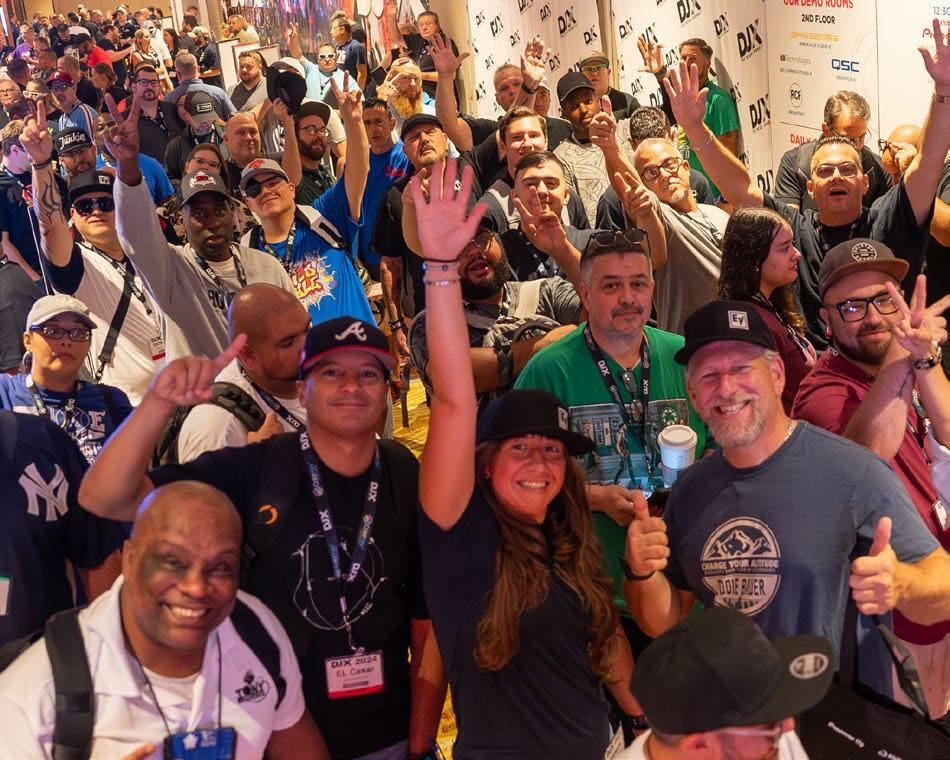
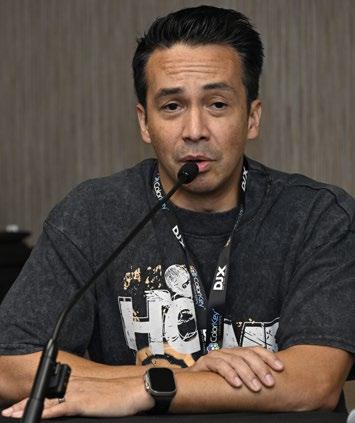
Ronald Mungo
What’s New: The DJX Sunset Sessions offered new opportunities for brands and attendees to connect over a relaxed environment that included food, drink, music and giveaways. On Aug. 5, QSC’s session in its demo room presented Jaymie Perez on the decks, while brand reps lauded and toasted DJX attendees and the DJ market. On Aug. 6, AlphaTheta held its session outside, which afforded attendees views of the Atlantic Ocean, as DJs played thru the company’s OMNIS-DUO controller and WAVE-EIGHT speakers.
The showfloor also featured the debut of THE EDIT Studio, which showcased studio/production and content-creation technologies. Its brands included: Audio-Technica; Crate Hackers; DJ.Studio; Jdrumz; Mixed In Key; Open Studio Space; rekordbox; and RCF.
Also, Grammy-nominated DJ/producer Scram Jones, in collaboration with DJX, launched The Scramble, which showcased a lineup of diverse DJs that included Puffy, Throdown, Skribble, K-Sprinkles, Mell Starr, AS 1, Buck Rogers, and Nick Spinelli. Hosted by Rock And Soul at the Technics booth on Aug. 7, The Scramble presented the DJs performing open-format sets centered around the “scrambling” of music genres, while incorporating the market’s newest DJ technologies.
The Prizes: On Aug. 8, Dennis “DJ Kwick” Alcaino of Global Sound DJs & Entertainment in Sunrise, Fla., won the Ultimate DJ Giveaway. The winning system included products from the following exhibitor/sponsors: AlphaTheta Music Americas (AlphaTheta OMNIS-DUO controller, two Pioneer DJ XPRS2 loudspeakers, and Pioneer DJ XDJ-X7 headphones); BV Mobile Apps (BV Mobile Apps Platinum Service); ColorKey by Mixware (two Mover Spot 150 moving heads and two LS8 8-foot lighting stands); Electro-Voice (two EVERSE12 loudspeakers); Esstart (Instant Spotlight); Headliner by Mixware (Indio portable DJ booth); JetPack (JetPack Slim Backpack); JMAZ (Firestorm F3 Chrome 2 Pack); Mixed In Key (Complete Collection); Odyssey (Odyssey Smart Laptop Stand with High-Speed 3.2 Media Hub); RockNRoller by Warm Audio (RockNRoller Multi-Cart R12STEALTH); Ultimate Ears (two pairs of UE-11 PRO in-ear monitors); and VIBO DJ (VIBO Touring DJ camo backpack).
Just Announced: DJX ’25 will run Aug. 11-14, again at the Hard Rock Hotel & Casino in Atlantic City, N.J.


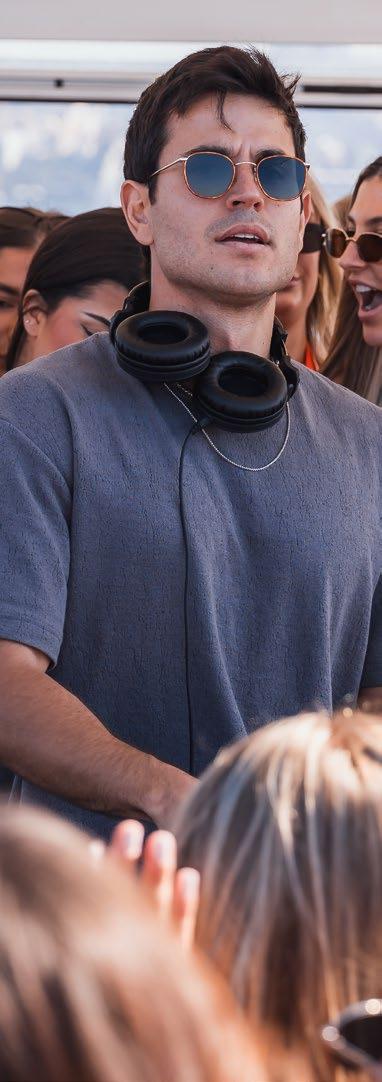


The 4th Annual SKAM Summit Delivers Tech, Talk & Beats By Jim Tremayne
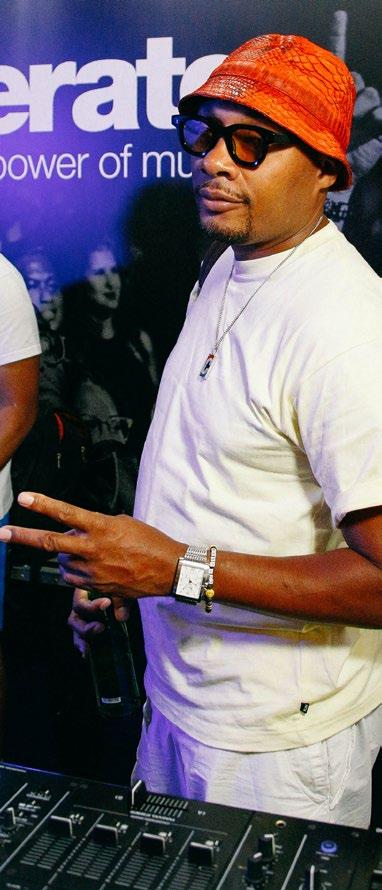
By Mark Mancino
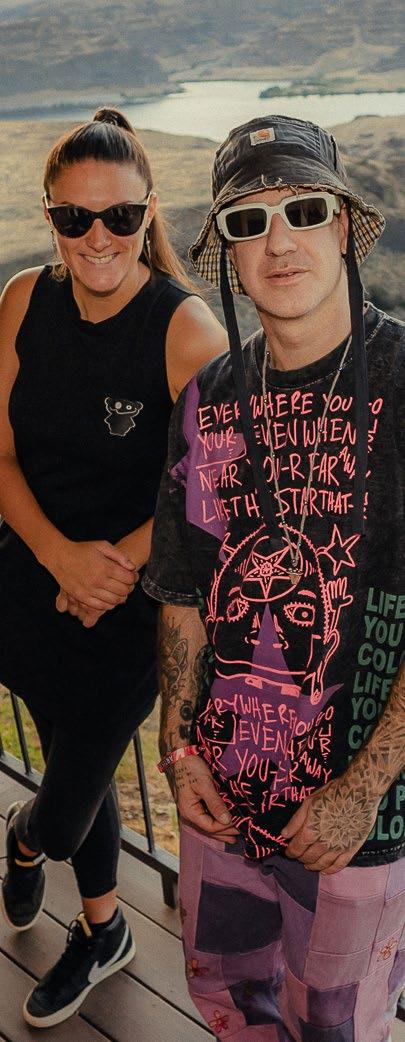

the Beats to the Paris Olympics’ Breaking Competition, DJ Fleg Takes the Art Worldwide
Tremayne
8 Feedback Attendee & Exhibitor Feedback from DJX ’24
36 Festival Spotlight
North Coast Festival
40 Playback AlphaTheta euphonia & Sensaphonics dB Check Pro 42
Alpha 80 Evo Monitors
BES Entertainment
the YouTube Algorithm 48 Gear
Products from AlphaTheta, ADJ & More 54 Tracks Phat Tracks from Random Soul, Tenacious & More
56 Club Play Chart
Hottest Records, As Reported by Our Top U.S. Record Pools
When you think about the Olympic Games, the idea of DJs rarely comes to mind. But in its recent edition, held this past August in Paris, the breaking competition became all the rage on TV. While the reasons were both silly (a goofy meme-fest) and fascinating (a terrific competition), a pair of DJs were at the center of it all, spinning the music that allowed the dancers to make their moves. So, in this issue we connect with Brooklynbased Stephen Fleg (aka DJ Fleg), who shared the DJ booth with Polish jock Plash. A longtime participant in the breaking culture, Fleg’s been a B-Boy (i.e., dancer), event promoter, and chosen DJ who lays down the beats for competitions. As soon as The Olympics ended, we connected with DJ Fleg, who told us his story.
As we ease into Amsterdam Dance Event week, we re-visit with legendary techno DJ Dave Clarke. The Brit-born/Amsterdam-based talent has just re-released a crucial part of his influential catalog that’s been unavailable for more than two decades. So, in our Q&A, he offers the details on how it all worked out in the end. In another feature, our Mark Mancino interviews CloZee and LSDREAM and they explain how they’ve come up with a unique collab – LSZEE.
In the Sound Bites section, we connect with Miami-based turntablist DJ Knockers, who explains his journey to the 2023 DMC USA championship. Also, our Mr. Mancino interviews Levi, who has been riding high this year on the strength of his viral single, “Jump.” In Festival Spotlight, we present the scenes from Chicago’s North Coast Festival, which brought some of EDM’s biggest acts. Additionally, we bring the highlights of LA’s SKAM Summit, which delivered tech, talk and beats.
Moving to our gear-review sections, Wesley King handles Focal’s Alpha 80 Evo monitors in the Studio Session department. And in Playback, readers get a twofer this month – Wes reviews Sensasonics’ dB Check Pro audio analyzer, while DJ Deets checks out AlphaTheta’s euphonia rotary mixer.
Onto more mobile matters, in Mobile DJ Profile, we connect with Michigan’s Matt Besemer and his BES Entertainment, which plays events, rents out gear, and installs soundand-lighting at area venues. In Business Line, Jordan St. Jacques analyzes the YouTube algorithm and explains what it means to DJs.
Of course, this is our first issue since DJX. Held this past Aug. 5-8 at the Hard Rock Hotel & Casino in Atlantic City, N.J., the show brought the DJ world together again. Produced by DJ LIFE and Hazan Media Group, DJX presented nearly 40 educational seminars, an exhibit hall full of the latest technologies and sponsored After Dark events. You can read about it in our Pg. 3 News section and in our Pg. 8 Feedback section. Additionally, you can see six pages of images from the show, starting on Pg. 20. As always, a big thank-you goes out to all participants – exhibitors, attendees and performers alike. Looking forward to seeing you at next year’s show – Aug. 11-14, same venue. For the latest info, please visit www.djxshow.com.
Cheers,
Jim Tremayne Editor, DJ LIFE

editor-in-chief
Jim Tremayne jtremayne@hazanmediagroup.com
editor-at-large Brian O’Connor boconnor@@hazanmediagroup.com
web editor and social media manager Mark Mancino mmancino@@hazanmediagroup.com
contributors
Wesley King, Chris Caruso, Amanda Chavez, Shawn Christopher, Paul Dailey, Reed Dailey, Chris Davis, DJ Deets, Tony Fernandez, Tommy D Funk, Lexi Ferguson. Greg Hollmann, Danielle Johnson, Erik Miller, Lily Moayeri, Jordan St Jacques, Jeff Stiles, Ashley Teffer, Danny Turner, Phil Turnipseed, Joshua Volpe, Travis Wackerly, Curtis Zack
chart coordinator Dan Miller dmiller@hazanmediagroup.com
director of sales Josh Kerman jkerman@hazanmediagroup.com
creative director Janice Pupelis jpupelis@hazanmediagroup.com
director of technologies and project management Steve Thorakos sthorakos@hazanmediagroup.com
Chairperson & COO/Co-Publisher Robin Hazan rhazan@hazanmediagroup.com
President & CEO/Co-Publisher Shawn Hazan shazan@hazanmediagroup.com
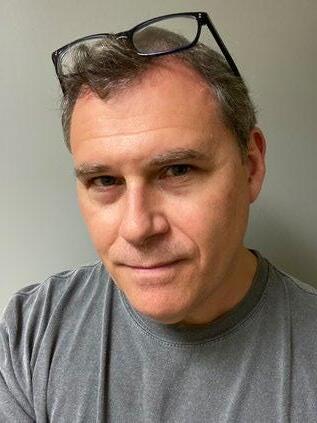

visit our website: www.djlifemag.com 516.767.2505
Editorial and Sales Office: DJ Life, Oyster Bay, NY 11771. (516) 767-2505 • (Sales/all other business): (516) 767-2505 • djlife@hazanmediagroup.com.
Editorial contributions should be addressed to The Editor, DJ Life Mag, Oyster Bay, NY 11771 or sent to JTremayne@hazanmediagroup.com.
DJ Life Mag is published bi-monthly starting with the second month annually.
Design and Contents: copyright © 2024 by DJ Life Mag and must not be reproduced in any manner except by permission of the publisher.
Web: DJLifeMag.com DJXShow.com and HazanMediaGroup.com
Subscriptions: Complimentary Digital Edition. Email: djlifemag@hazanmediagroup.com Phone: 516-767-2505 ext. 502 Web: djlifemag.com/subscribe
| VOL.4 NO.5





Atlantic City, N.J. – DJX’24 ran this past Aug. 5-8 at the Hard Rock Hotel & Casino in AC. Produced by DJ LIFE and Hazan Media Group, DJX presented DJcentric exhibits, educational seminars, and sponsored After Dark events. Here are responses from show exhibitors and attendees:
“This year’s DJX was our best experience to date. Our demo room was packed throughout the show with highly engaged and enthusiastic DJs looking to offer a premium experience for their clients. The show exceeded our expectations in terms of number of visitors to our demo room, as well as the positive feedback we received about our products and our brand. We can’t wait to be back next year.”
– Ray van Straten, QSC, Costa Mesa, Calif.
“DJX 2024 was an incredible success… This year, we reinforced our commitment to supporting the hard-working DJs who, week after week, rely on top-tier performance speakers to power their events. From our booth to the vibrant EV DJX Influencer activation area, we are thrilled to have been part of DJX – such
a dynamic event – and we look forward to continuing our support for the DJs who trust in Electro-Voice.”
– Marco Arujo, Electro-Voice, Burnsville, Minn
“I have been coming to Atlantic City in August since 2006, and the show gets better every year! DJX has become the gold standard for a DJ show, and I can’t wait until the DJX ’25 to again see some amazing people, vendors, and shows – and to make new DJX memories!
– Jay Brannan, AlphaTheta Corp., Torrance, Calif.
“The night-time events were the best ever, especially the closing party! I haven’t danced that much in years. Looking forward to DJX ’25!”
– John Feelgood, The Scene Kings, NYC
“Thanks to the team for the continued hard work and effort at DJX and at DJ LIFE magazine. I look forward to next year’s show.”
– Juan Posso, IDJNow, Ronkonkoma, N.Y.
“DJX continues to get better and better year over year. The conversations in the halls and the sessions are a great juxtaposition to the high energy and intensity of the exhibit hall. This is a ‘must-attend’ for any DJ who’s looking to grow and level up.”
– DJ Hapa, The DJ Coach, Los Angeles
“DJX is the perfect event to showcase all our brands’ latest offerings and it offers valuable face-to-face time with DJs, industry tastemakers, and top artists. The 2024 DJX was bigger and better with an all-new layout and new, engaging content. “
– Dave Arevalo, Mixware, Sun Valley, Calif.
“Every year, I go to DJX. Sometimes I speak, sometimes I exhibit, and sometimes I just go to go. This year, I did all of those, and it was well worth the trip up from North Carolina. This conference just keeps getting better. I’ll see you all again there next year!”
– Joe Bunn, Bunn DJ Company, Raleigh, N.C.






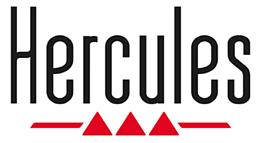





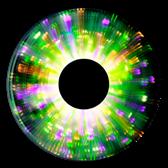







If at first you don’t succeed… maybe you should listen to your wife. That’s what Scott Koltun did, and it helped him become a national-champion turntablist.
In his quest for the 2023 DMC USA crown, Koltun (aka DJ Knockers) stumbled in a regional competition, but was encouraged by his wife Jenni (and DMC co-organizer Christie Z. Pabon) to enter the USA final competition in New York as a wild card. After much tough reflection and more than a little support from his partner, Koltun submitted a last-minute entry to the finals and made his way to Gotham.
His finals routine, which included cinematic snippets, deft on-beat tricks, and a tasteful mixture of musical genres
that stretched ethereal passages into drum-n-bass breaks, was stellar. The judges were impressed and that night he walked away with a championship nobody can ever take away from him. A little encouragement can go a long way.
We caught up with the Miamibased DJ Knockers, 36, to discuss his journey from late-blooming DJ to DMC USA champ.
DJ LIFE: Where did you grow up?
Knockers: I grew up in Miami, Fla., which is a very unique place. I love the eclectic grouping of people and the different types of music that you can hear. It is very much home to me.
DJ LIFE: Growing up there, how much was music a part of your life?
Knockers: It was, for sure, my parents love music. My mom and my dad are from immigrant families and music was on all the time. We had Spanish parties where my family would be dancing and singing along. Music was always around and my parents were willing to let me listen to anything.
DJ LIFE: When did you get started in DJing?
Knockers: I was actually a late bloomer, compared to many other DJs I’ve met. I really didn’t start getting into DJing until I was in college, around 22 years old or so. My first experience with DJing was at an open-house class at the Scratch DJ Academy in Miami, and eventually I became a student there. That’s where
I was introduced to all the things that I fell in love with down the line.
DJ LIFE: After that, when did you start getting interested turntablism and competitions?
Knockers: After the first class, I knew DJing was fun, but I didn’t love it. It just felt like another thing. What really got me interested – and I can pinpoint the exact moment that I fell in love – was when I was introduced to the DMC Championships.
DJ LIFE: As a DJ, why did the DMCs move you so much?
Knockers: The DMC battles are one of the longest-running DJ battles, and it’s just the most hardcore technical DJing that there is. It started as a mix competition, but eventually became home of the scratching and juggling and body tricks – and that’s where people went to push the envelope. So, when I saw routines, it blew my mind. I’d never really given any thought to scratching until I saw that. When I saw people doing battle routines for the first time, that was the moment. That’s what clicked, and I was like, “That’s what I want to do!” I had never had that “a-ha moment” before.
DJ LIFE: Was the competitive aspect of the DMC Championships attractive to you?
Knockers: Definitely. I think I’m probably overly competitive. Whatever it is – sports, video games, cards – I always want to win. So, I think that helps because it gives me that extra energy to want to be better. Scratching and DJing was also my first kind of artistic outlet in any way. So, learning to express myself and have almost meditative practice with music, that just happened at a good time for me, I guess.
DJ LIFE: When was your first-ever competition?
Knockers: I started competing in 2015 when I was 22, relatively quickly after taking classes. Luckily for me, the head instructor at the academy there, DJ Immortal, was another U.S. DMC champion and he was practicing and that’s kind of where it started. I started asking questions, and he showed me a YouTube video from the 1990s, and I did more research. And yeah, there’s just such a rabbit hole to go down. There’s so many battles and so many iconic figures and moments and history that you have to learn about – and I was hooked.
DJ LIFE: How long did it take for you
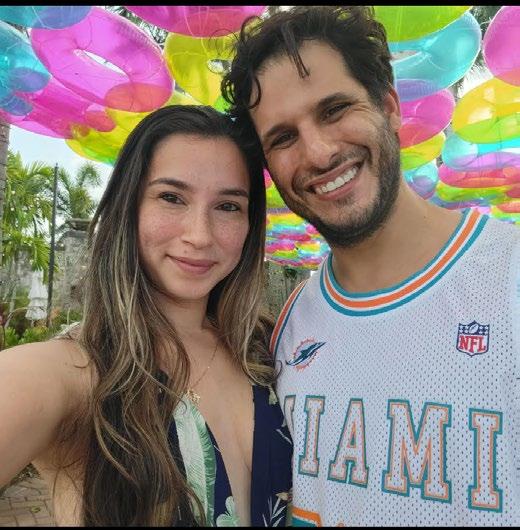
to realize you might be pretty good at it?
Knockers: At the beginning, I didn’t really take it seriously. It was more for fun. But my competitive nature took over and then I set a goal to win those battles. So that’s when I started practicing harder and there was maybe a two- or three-year period there where I was practicing like crazy. So, by 2016, I was ready to enter and actually compete at a higher level. In the early days, I finished second a lot – I mean, a lot! It took maybe another year to break through and start winning.
DJ LIFE: Tell us about your experience winning the DMC U.S. Championship… what do you remember about the journey to the title?
Knockers: I won the 2023 U.S. championship with the classic six-minute routine. It’s a regional battle first, so people compete in their region and then eventually the winners get together one more time for another battle. I actually didn’t win my regional, so that’s a pretty funny story. I messed up in my regional competition in Tampa, and it was a pretty obvious mistake. If you make a mistake at this level, it’s kind of hard to win. But I was encouraged to enter the finals anyway as a wild card. Christie [Z. Pabon], the organizer said, “You should enter the finals. You were good enough. You should have won, but you messed up. So, make sure you don’t mess up and you should come to New York.” To be honest, I didn’t want to go to New York. I said to myself that, I didn’t earn it, and “no, I’m done.” But my wife, Jenni, told me that I needed to go. With her insisting, I changed my mind and decided to go. It was really close to the deadline. We then traveled to New York and, I
don’t know, I guess it was my night.
DJ LIFE: So, you have your wife to thank for winning the U.S. Championship?
Knockers: Yeah. 100-percent. Jenni is the best. The best! I think this is such a weird life, the life of a creative. You need to have a supportive partner, someone who understands.
DJ LIFE: What does your gear set-up look like when you compete?
Knockers: Almost always two Technics SL-1200 turntables and a Pioneer DJ mixer. I mostly use the Pioneer DJ DJM-S11 at home. Also, I use the Phase controller, which is a gamechanger for high-pressure, loud, bassheavy environments – no skipping needles. I can play with a lot more confidence in those competitive situations.
DJ LIFE: What’s next for you and your career?
Knockers: I am currently doing a lot of teaching, either online teaching or in-person teaching. It’s an opportunity to give back and teach the next generation. I’m actually teaching at the DJ Academy where I started learning. I felt early on in my DJ career that I wanted to start teaching because it’s good to surround yourself with other people that are trying to learn. It kind of lets you allow yourself to learn. You have better energy in your daily practice.
DJ LIFE: Will you be competing again in the future?
Knockers: I am at a really weird place because I honestly don’t know. If I had a DJ life goal when I first started, it was to win the DMC U.S. Championship. I did it and now I’m it’s kind of reassessing and figuring out how I want to keep going. I have some other areas of interest, like music production. I do some producing, including all the editing in my routines I have to do, but I want to create some more original stuff to leave the world. I want to leave something that my kids can listen to.
DJ LIFE: What advice do you have for DJs?
Knockers: Be yourself. Be original. Invest in yourself the time, but more than anything else, you gotta find your own voice and do it your way. To push yourself to that 1-percent, it takes originality, it takes a willingness to fail and try new things and try to experiment and push forward. Hopefully, you’ll rise above, eventually.
– Jim Tremayne
Levi is a breakout DJ/producer based out of New South Wales in Australia, and he’s exploded onto the scene this year with the release of his viral single, “Jump,” on Get Together Records.
Born Levi Neufeld, the 30-year-old isn’t really an overnight sensation, as he’s been producing and playing shows for five years before this year’s single began to dominate the circuit.
From playing events like Ralph Lauren’s Australian Open party, opening for the GRAMMY-nominated Kehlani, an official after-party for Anderson .Paak, and Your Paradise Fiji , Levi is finally able to perform his original music in latest sets, which of course, includes “Jump.” The song was released in late March, just in time for the start of

festival season in the U.S., and since then, it’s been streamed more than 35 million times on Spotify alone. When it comes to influences and music motivators, Levi says he finds inspiration in electronic music that’s heavily influenced by R&B. Discovering artists like Keinemusik, Sonny Fodera, and Jaydon Lewis in addition to acts like Groove Armada, who was his first introduction to electronic music, Levi has developed his production style and honed in on crafting his own Afro-beat-leaning sound. His passion for combining R&B and electronic is apparent on his smash hit “Jump,” which incorporates elements of Ginuwine’s 1996 hit, “Pony.”
DJ LIFE caught up with
Levi to chat some more about how he got his start as a DJ and producer, the seemingly overnight success of “Jump,” and where he intends on going from here. Here’s what he had to say upon our recent sit-down…
DJ LIFE: When did you begin to explore electronic music?
Levi: I’ve been heavily influenced by R&B, and through exploring different genres adjacent to R&B, I came across artists like Keinemusik, Jaydon Lewis, Sonny Fodera, and so on. But my first introduction to electronic music was Groove Armada as a child, such a unique sound at the time and really captivating.
DJ LIFE: What came first for you – DJing or producing in the studio?
Levi: Playing the guitar was the first introduction to music, then went into DJing later, as I started to go out more and watch DJs play. That definitely pushed me to dive further into production and producing. DJing allows to create a vibe and producing music allows you to create a moment – both I absolutely love.
DJ LIFE: When it came to your first-ever DJ set-up and DAW, what did you initially learn to DJ with and what was your studio setup like?
Levi: Pioneer DJ’s XDJ-RR [2-channel, all-in-one system] is great to familiarize yourself with Pioneer decks, and Ableton Live for production. I used a Focusrite Scarlett 2i2 for an interface and KRK monitor speakers. It’s a simple set-up, but it’s literally all you need!
DJ LIFE: Since your recent success, have things changed for you? If so, how?
Levi: A lot more flights now, and a lot more people. It’s really cool travelling around and being able to play in different cities… all

this from music that I absolutely love. There are still constants in my life that I enjoy – I love being home.
DJ LIFE: In the studio, what are some of your go-to programs, plug-ins, sample packs, etc.?
Levi: Serum [from Xfer Records] is the go-to for almost all synth sounds –it’s user-friendly and really versatile. I use Omnisphere [from Spectrasonics] for something more detailed, and it has some insanely beautiful sounds. As for samples, ANH, who’s an Australian producer, makes great sample packs.
DJ LIFE: Tell us a little bit about your single “Jump,” which you released earlier this year. What does the song mean to you?
Levi: “Jump” represents my breakthrough into this world of dance music. I was completely floored by the response to it and how well it caught online. I produced it at home and now it takes me around the world, bizarrely enough.
Levi: It’s definitely the biggest song in my sets and super engaging from a fan perspective, too. A lot of shows this year have been in some incredibly beautiful outdoor venues. The song captures this little essence of summer that I think people enjoy.
DJ LIFE: When showing up to a gig, what are three songs you always have on your USB?
Levi: “Jump,” of course –that’s obvious! Also, Route 94’s “My Love” featuring Jess Glynne. This song really connects – it’s kinda underappreciated. Jess Glynne’s vocal on it is amazing! Also, “Contesto” by Dos Amis. Response to this track in my sets has been crazy –just great energy on this record. It can be different countries, but always the same energy.
DJ LIFE: Did you have any expectations for the record since its release during this year’s festival season? Any inkling it might do very well?
Levi: No, I had no idea this song would lead to touring Europe and selling out shows. It’s still not lost on me how difficult it is to have songs connect with an audience. You can’t really plan it, nor do I look for it in a song. I just make what I love and share it.
DJ LIFE: Are you frequently playing more shows now? What has that record done for you?
Levi: Oh definitely, more shows. “Jump” has definitely been a catalyst to my growth as an artist. It’s also allowed me to showcase some more of the music in my sets, which has been really rewarding. I have a lot of music still to come, and it’s hard being patient.
DJ LIFE: From release until now, when you play “Jump” during a set, what type of response have you typically been receiving?
DJ LIFE: As a breakout DJ/ producer currently enjoying a peak, what advice can you offer to those persistently trying to break through?
Levi: Consistency is key and just keep going. It took me four to five years to essentially break through overnight. It takes a lot of patience and a lot of planning, trusting your music, and always loving what you’re putting out first. Don’t do it for hype or attention; do it because you love it.
DJ LIFE: Tell us what we can expect to come from Levi
Levi: There will be new music with some really big U.K. and U.S. artists. There will be new shows with some beautiful locations. I’m looking to ramp up the amount of music for the end of the year and into 2025, Some releases I’m really excited about with some new soundscapes, always evolving.
– Mark Mancino

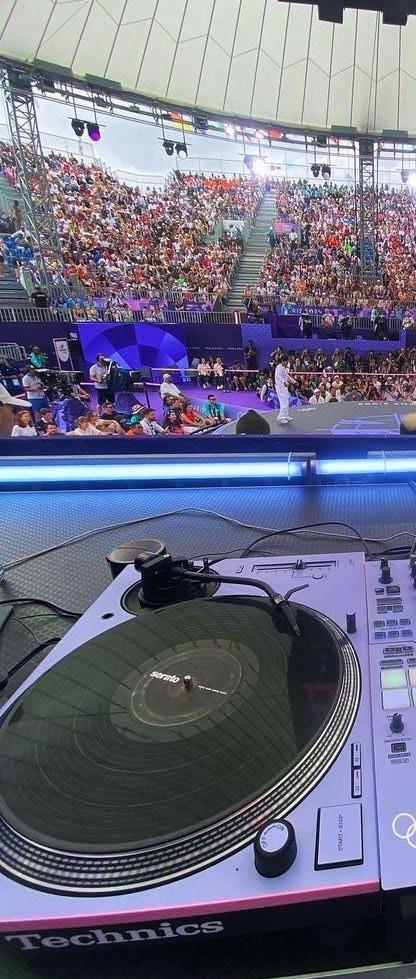
By Jim Tremayne
Bringing the Beats to the Paris Olympics’ Breaking Competition, DJ Fleg Takes the Art Worldwide
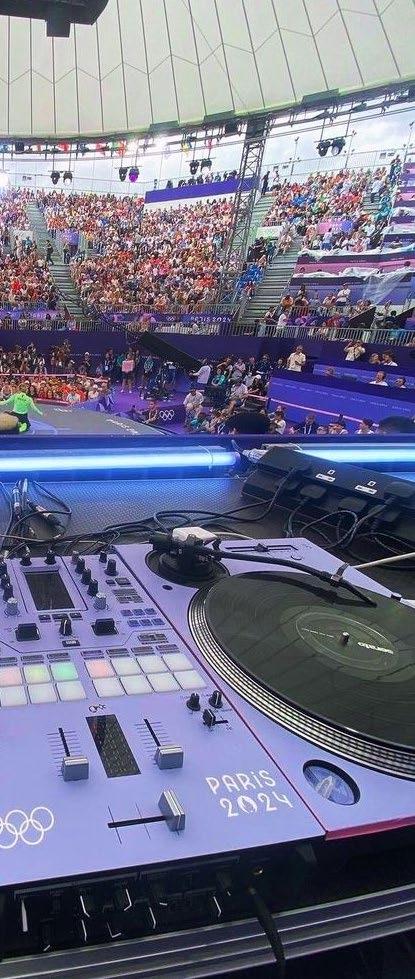
Until his DJ skills were broadcast worldwide this past August, Stephen Fleg wasn’t much known beyond the U.S.-born culture known as breaking (or, to civilians, breakdancing).
But in that relatively insular world, Fleg had been a longtime somebody , as he’s participated deeply in almost every way – as a B-Boy (i.e., dancer), event promoter, and choice DJ. His profile was raised to a new level a decade ago when he began to spin for the Outbreak 10 and, later, the Red Bull BC One competitions. In fact, he’s spun each Red Bull competition since 2014. Fast-forward from there, and the 2024 Paris Olympics came calling... and with that, a global spotlight was not only for him, but also the culture he loves.
For all breaking competitions, the Olympics included, the DJ’s job is to spin the best tunes available so that the dancers can let loose with their array of intricate moves. Judges evaluate and mark the moves from three categories: toprock (standing moves), downrock (spinning, footwork, drops and transitions) and freeze (a stop in an acrobatic position). Additionally, there are many times when the DJ must create his or her own edits or original music to avoid sticky music-rights issues. Luckily, for The Olympics, the pockets were deeper, so Fleg and his fellow DJ, Plash, had nearly 400 cleared tunes from which to choose.
As many of you already know, much of the Paris competition gained a degree of infamy due to the inane social-media meme-fest generated by the less-than-sharp performance Australian competitor Rachael Gunn. But for anybody watching the event, which ran Aug. 9-10 at Place de la Concorde, riveting and spectacular efforts were the norm, with Fleg and Plash delivering the classic breakbeats along the way. Although the American breaking culture is more than 50 years old, the competition afforded something new for The Olympics and it took breaking to an unprecedented level –plus it made for some terrific television in the dead of summer. And, as always, some busy DJs were keeping the beats flowing.
As soon as the Paris competition concluded, we caught up with the Maryland-born/Brooklyn-based Stephen Fleg, 38, to discuss his Olympic experience, the culture of breaking, and his experiences along the way.
DJ LIFE: Where did you grow up and how did you get interested in music? What were the first musical things that caught your attention and why?
Fleg: I grew up in the suburbs of Baltimore and was always involved with music in as a kid. I played in school jazz bands and orchestras since I was 8. My father is a jazz trumpeter, my grandmother was a concert pianist and my great grandmother was a concert pianist as well. There was music in my house – jazz or hip hop from records, as well as the sound of my brothers practicing scales and tunes on the clarinet or piano. When I got into high school, I started to develop my own taste in music and I went deeper into funk, hip hop and psych rock.
DJ LIFE: In your area, what was the music scene
“Make The World” by Lee Fields & The Expressions (2016)
“Wendo” by M’Bamina (1973)
“America in 2020” by DJ Fleg & The East Coast Affair (2020)
“Rock” by DJ Spinna (1999)
“Give It Up or Turnit a Loose” by James Brown (1969)
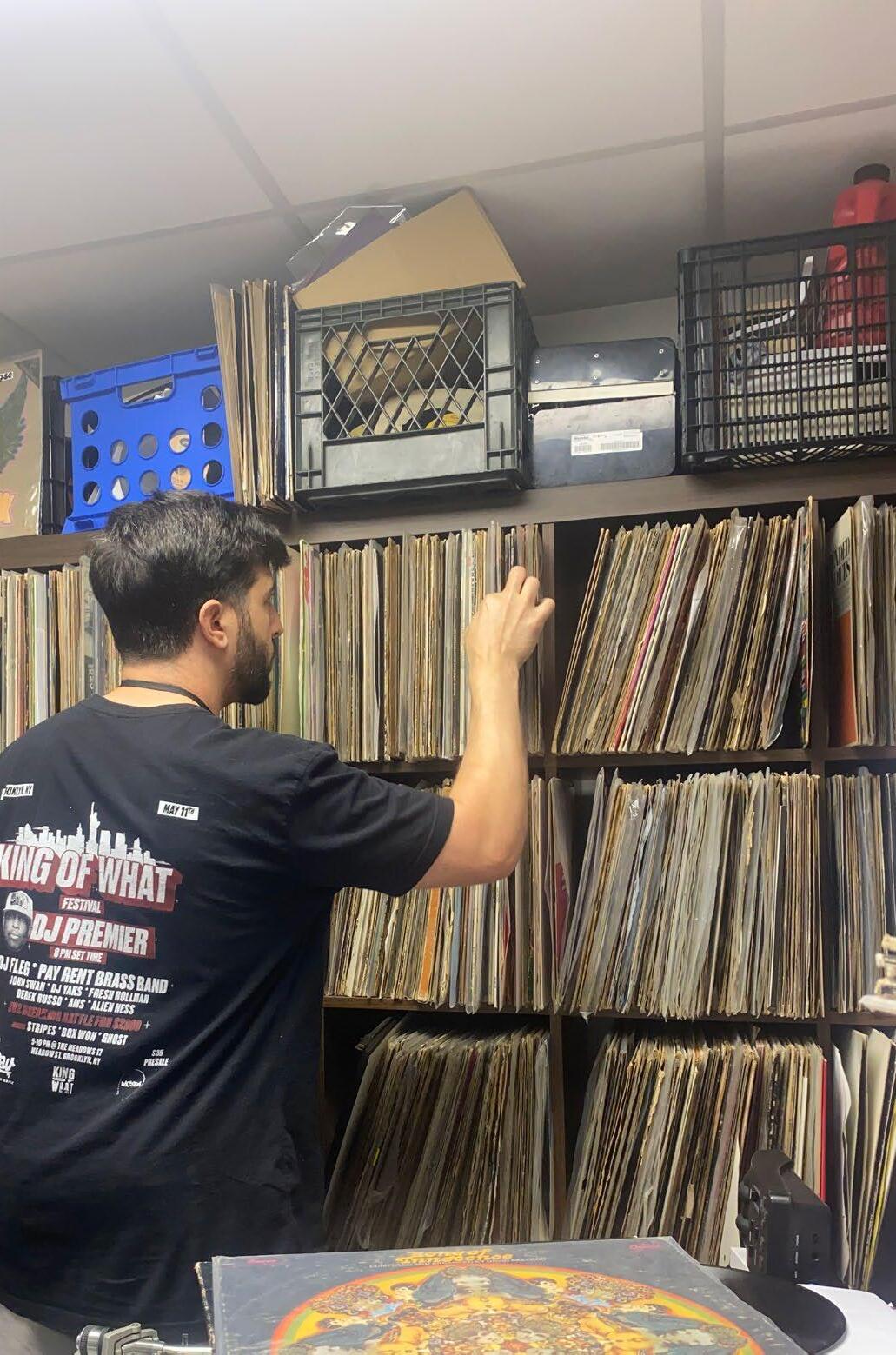
like?
Fleg: In my original area, growing up, there was very little scene for anything. I played music with my high-school bandmates, learned how to break with my buddy Darrem and started to learn how to use a Boss SP-303 sampler in my bedroom. In order to actually experience bigger, more comprehensive scenes, I had to go to Baltimore or D.C. for events. It was during my time living in Baltimore that I really cut my teeth DJing and learned how to play for a crowd.
DJ LIFE: I read that you really began as a B-Boy. Did you have any heroes in that regard?
Fleg: Yes, I had tons of heroes in breaking: Bboy K-Mel, Ken Swift, Remind, Rawbzilla, Ruen, and many others were killing it in the late ’90s early 2000s, and they were some of my favorites. Note: We call it breaking, not breakdancing, as that term was given to us after the boom in the ’80s, but was not ours per se.
DJ LIFE: When did you start going to clubs and parties? What were they like?
Fleg: I first started going to parties in 2004 or so. I didn’t go out that much, but would find myself in the legendary Paradox club in Baltimore. Later, in
2009, I began my own monthly party, 4 Hours of Funk, which lasted for 10 years. The Paradox always hosted different styles of parties – from raves to vogue balls to house-music nights featuring Baltimore’s many legendary house artists like the Basement Boys, Karizma, Crystal Waters, etc. From going out to the clubs and playing with my good friend Graham Hatke at 4 Hours of Funk, I learned about the Baltimore “sound” and that impacted my style to huge degree. Some that sound I had already been aware of, as I often listened to radio mixes on 92 Q and V103 as a kid.
DJ LIFE: So, when did the DJing begin?
Fleg: I first got turntables in 2001 with the sole idea that I would learn how to scratch. I DJed my first breaking jam in 2005, but I didn’t really begin DJing a lot until 2008. I started to play more breaking events locally around 2008 and, in 2009, I played at my party every month.
DJ LIFE: What DJ gear did you learn on? What was your biggest challenge?
Fleg: I learned on Numark TT-1520 turntables, which were not that great to learn on, as the platter wasn’t steady. In 2003, I got my first pair of Technics, which I still use today! Given that I was playing all-vinyl, it was important for me to have a really solid turntable and mixer to properly cut. I had a Vestax PMC-05Pro mixer, which helped me to do scratches better since the crossfader cut better than the Numark mixer I started out on.
DJ LIFE: Your studio work is both artistic and purpose-driven. How long have you been making music?
Fleg: I’ve been seriously producing since 2009, with little attempts at it since 2002. I do a lot of edits and original tracks. For me, there are two modes I have: Making edits/remixes for club/ breaking event use and making original tracks that often contain zero samples, but that aim to replicate that “vintage sound.” Those original tracks can be heard in my album True Colors by the East Coast Affair, my band. I wrote, arranged and played on all of those tracks and also had key help from folks like J-Zone, Ivan Khatchoyan, Carrtoonz, Homer Steinweiss, King Los, Sam Koff and many others.
DJ LIFE: What’s your principal gear in the studio you use?
Fleg: My studio gear varies depending on the project. Sometimes I have to outsource to get the type of drum sound I’m looking for, and sometimes I can handle it in-house. I love using upright pianos, Fender Rhodes pianos, Moog synths, Hammond organs, Clavinets and basically any keys used in ’70s recordings. I produce using Logic Pro 9 and 10 with Kali monitors. I pretty much use all stock plug-ins.
DJ LIFE: When and where did you begin to spin breaking competitions?
Fleg: I began spinning breaking competitions consistently in 2009. It started with local events



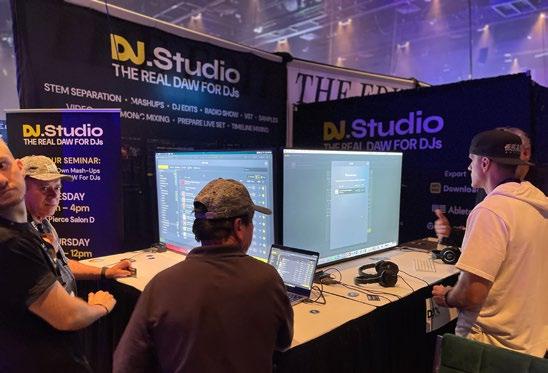


Karizma. “Insane mixing style and huge Baltimore inspiration.”
DJ Spinna. “Full package when it comes to production and an absolutely killer DJ as far as taste and skill go.”
DJ Premier. “Hip-hop producer royalty and also utilizes the mic to properly guide a party and potentially give you the chills in the meantime.”

and then it moved to DJing regional and then national events.
DJ LIFE: What special qualities must a DJ have for these kinds of competitions? What must the DJ understand? What prep goes into it?
Fleg: I think that spending a lot of time in our scene and really understanding what moves us is the most important thing! Usually, that involved being a dancer, as most non-dancers can only stand our scene for so much time. As you watch how dancers respond to certain known songs, you can then branch off into finding and introducing tracks that are new, but work for breaking. The prep involves understanding the scene and dancers and doing tons of digging to get the best possible music for the dancers.
DJ LIFE: Tell me about the Red Bull BC One and Outbreak competitions – how do those competitions differ?
Fleg: The Red Bull BC One competitions have been a big part of my DJ career and I’ve been DJing them since 2014. Red Bull has been one of the major sponsors of the breaking scene since the early 2000s and the BC One event is considered one of the biggest, if not the biggest 1v1 competition in our scene. Outbreak, started by the late Mex One, is a different kind of event with its roots in the cypher culture and a pure hip-hop vibe. Outbreak 10 is one of the best jams I’ve ever been to and Mex’s commitment to the culture and to helping absolutely everybody is a legacy that continues to reverberate.
DJ LIFE: How did that event help your profile as a DJ?
Fleg: Outbreak 10 was where I got “noticed,” and it led to me getting flown to Europe for the first time in 2014. In all of these competitions, my job is to DJ and provide the best possible music to the dancers, sometimes with no restrictions and sometimes necessitating the creation of tons of original tracks, as broadcast rights are notoriously tricky.
DJ LIFE: Why do you think breaking became an Olympic competition? To me, it makes for great TV.
Fleg: I think that breaking being an Olympic competition makes sense, as it’s no different than the existing “stage” battles that we have in our scene. The Olympic stage just happens to be quite a bit bigger, with way more reach. I also think it makes great TV. When people get away from the preconceived notions of breaking and just watch it, the talent level is undeniable, and it’s a sight to behold.
DJ LIFE: But the competition won’t be included in the 2028 Olympic games in Los Angeles…
Fleg: We’ve historically had this issue... Without getting too deep, I think that America’s relationship with Blackcreated art forms has always been fraught with negativity, which might explain why breaking made its debut in Paris, but will not be included in the 2028 LA Olympics. Somehow, as a society, we can’t help belittling this objectively cool-looking dance and the result is a lack of support for our dance, which explains why we’ve maintained a heavy underground presence since the ’80s boom and will likely return there after all of this is said and done.
DJ LIFE: It’s a rare event that puts the DJ front and center on global TV. With that much attention, what was that like for you and DJ Plash working the event? How did you two work together?
Fleg: That was definitely a wild experience, especially since we’re doing cuts and rocking doubles. Even with Serato, there still are a bunch of potential mistakes that can be made and making said mistakes in front of millions watching is a heavy thought. I thought DJ Plash and I did a great job of staying true to the culture stylistically and that we really made the competition feel – in a good way – just like any competition we would play on a local level. We split up the battle duties, which also made it a bit less work. Having only one DJ would have been an incredibly large amount of work and pressure, so I’m glad we were able to split things up.
DJ LIFE: How did you prep for the Olympics? Compared to other competitions, what was different about this event for the DJs?
Fleg: The prep for the Olympics was very involved, as we had a set list of songs, plus our own songs, that we could use, but there was no ability to play songs outside of that list. That meant I had to play my “style,” based on my original tracks and based on my choices within the song list.
DJ LIFE: How do you know what songs you’re going to play for each dancer?
Fleg: When I did my prep, I was looking for two or three songs – depending on the amount of rounds in the battle –that flowed well from one to the next, but I planned them having no idea which dancers I would be playing for. So once again, I just had to pick the songs, the transitions, etc., that would be good for any dancer. This is where knowing not just to play a classic, but knowing how to play a classic is important. Some songs can be played through from the beginning, some are only played for the drum break, just depends on the track.
DJ LIFE: How was the music chosen for the competition? What was that licensing process? I read that you ended up with a list of nearly 400 tunes…
Fleg: The music was chosen by DJ One Up, who was a part of the organizing committee in Paris. He and those he worked with know about the exact licensing process, but I had no part in that side of things. He selected a list of many tracks that were/are classics in the scene, as well as some deeper cuts as well.
DJ LIFE: What is your DJ-gear setup at the Olympics?
Fleg: The DJ setup was Serato DJ Pro software, two Technics SL-1200 turntables, and a Pioneer DJ DJM-S11 mixer.
DJ LIFE: Did you have any hairy moments or did things mostly go smoothly?
Fleg: I actually did have a hairy moment, as did the other DJ, Plash. Sometimes the needle doesn’t work properly on the Serato record if too much dust builds up, which can cause the track to warble and possibly even completely cut off. Luckily, he saved it and all was good for the battle, but these types of issues are very serious when you’re DJing for millions! I also had a crisis moment when I accidentally turned off my microphone tab on my computer, which unbeknownst to me, also cuts off the Serato signal. Given that I didn’t have any idea what was going on as I troubleshooted the typical issues, I had to put my songs on a USB stick and use Plash’s computer. Massive shout out to him for helping
me in that moment!
DJ LIFE: Why do you think the breaking competition in Paris created so much talk? The TV ratings were great.
Fleg: I think there is the obvious reason, which was the B-Girl who dominated coverage based on her not-great performance. But I think, as I mentioned previously, that this is an objectively incredible dance form. It’s not a sport! It’s a dance. Dances are often athletic, but it does not make them a sport. Humans are not typically spinning on their heads, defying gravity, doing creative movements that involve incredible strength like holding oneself on one hand. Therefore, when people see it, they instinctually look at it with intrigue. I am confident in saying that my friends who are the top breakers of the world have a level of physical genius that any other top athlete has. They know where their body is at all times, even while upside down or in motion, and this allows them to pull off spectacular moves.
DJ LIFE: What does it say for DJing and hip-hop culture that the world got to see a competition that’s usually done in clubs, school cafeterias and street corners?
Fleg: I think this was a huge moment for hip-hop culture, and I was super-happy to see bigger-name rap artists come out in support of it. The whole “From-The-Bronx-tothe-Olympics” is an incredible narrative that unfortunately got overshadowed by people on all sides. It’s odd how a penchant for negativity on the internet made us miss the most beautiful message that was embedded in this whole thing. Also, I think it’s amazing that people internationally, from Morocco, China, etc., that didn’t even have the clubs or school-cafeteria experience are also included in this competition because they’re some of the best dancers in the world. The sheer international participation in this scene was – and is – not fully understood by the American viewership.
DJ LIFE: Now that it’s just ended, what were your top memories of your Olympic experience in Paris?
Fleg: My most memorable moment in the Olympics was playing “The Mexican” by Babe Ruth for the last song of the final. I didn’t used to love that song that much, but it is a stone-cold breaking classic. The song has a ton of emotion in it and my good friend Phil Wizard really brought it out in a beautiful last-round moment. The cherry on top was having Alan Shacklock from Babe Ruth DM me, saying he appreciated me playing the tune. My other best moment was being done with the event and hanging out with my American homies afterwards, including [U.S. B-Boy] Victor [Montalvo], who brought home the bronze medal.
DJ LIFE: When you play non-competition gigs, what’s your musical repertoire? What kinds of events do you play?
Fleg: I love to play funk, disco, Brazilian music from the ’70s and ’80s and house music. I have really been enjoying playing all-vinyl gigs, as it limits me and makes me make very deliberate choices for a gig. I also have fun jumping around to different genres while keeping a “dancyness” to all of it.
DJ LIFE: Has your Olympic experience opened any opportunities for you? What’s next?
Fleg: What’s funny is that I had a packed schedule for the year, so there wasn’t much that came in the way of gigs – not yet anyway – but I might have some collaboration opportunities coming up in the future that I wouldn’t have otherwise had – so, that’s cool.















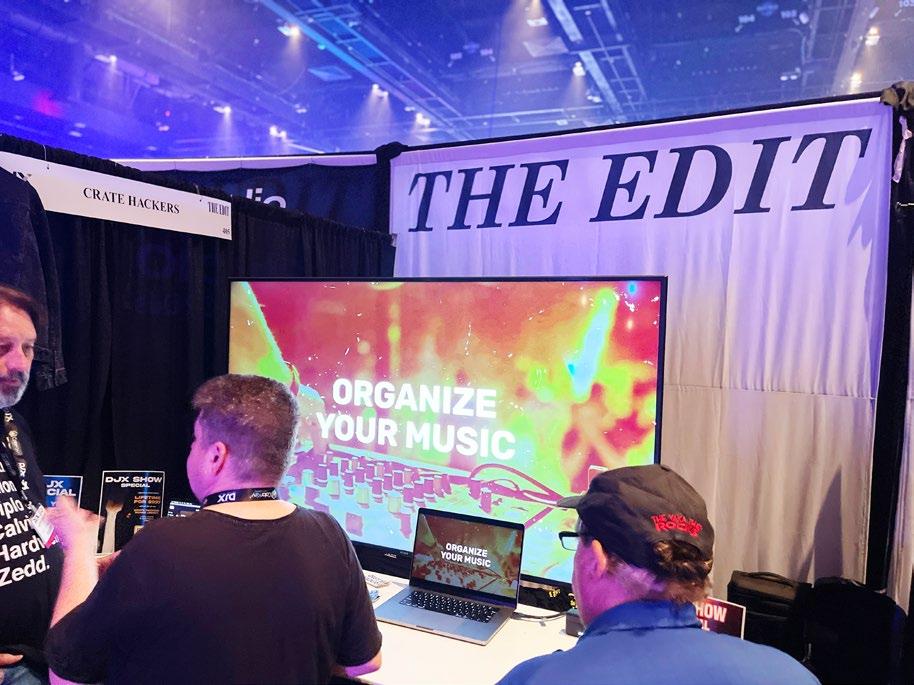






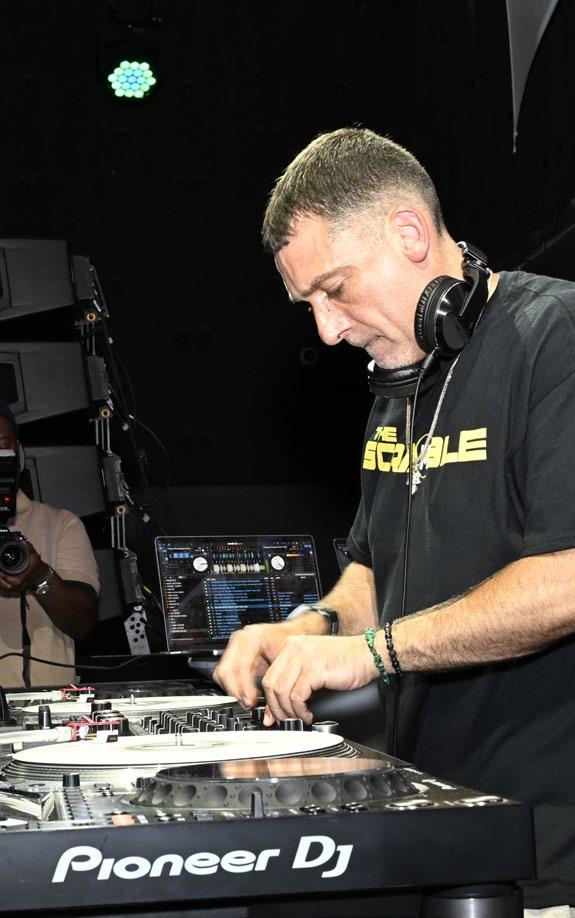




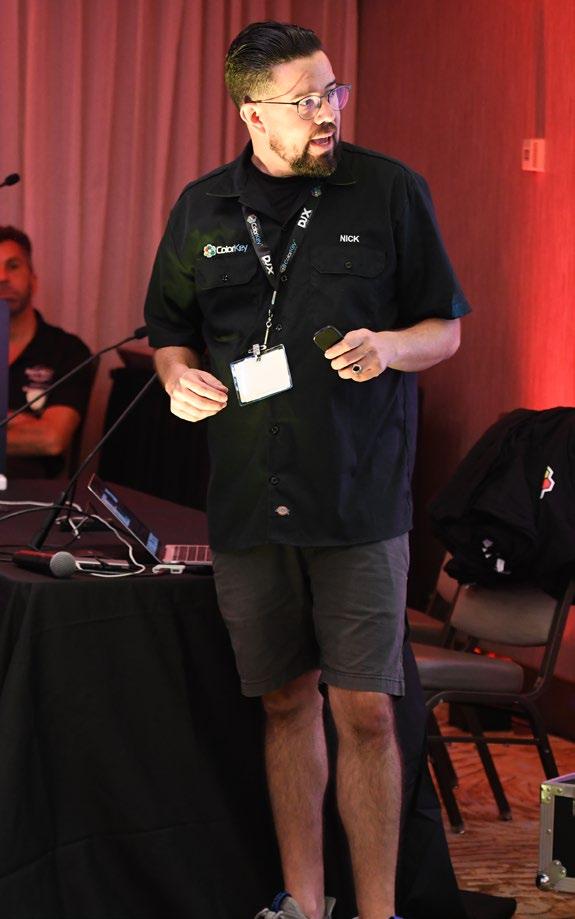



Lighting Seminar: ColorKey’s Nick Hernandez. Ronald Mungo
DJs: Holly T & CBJtheDream at HQ2.


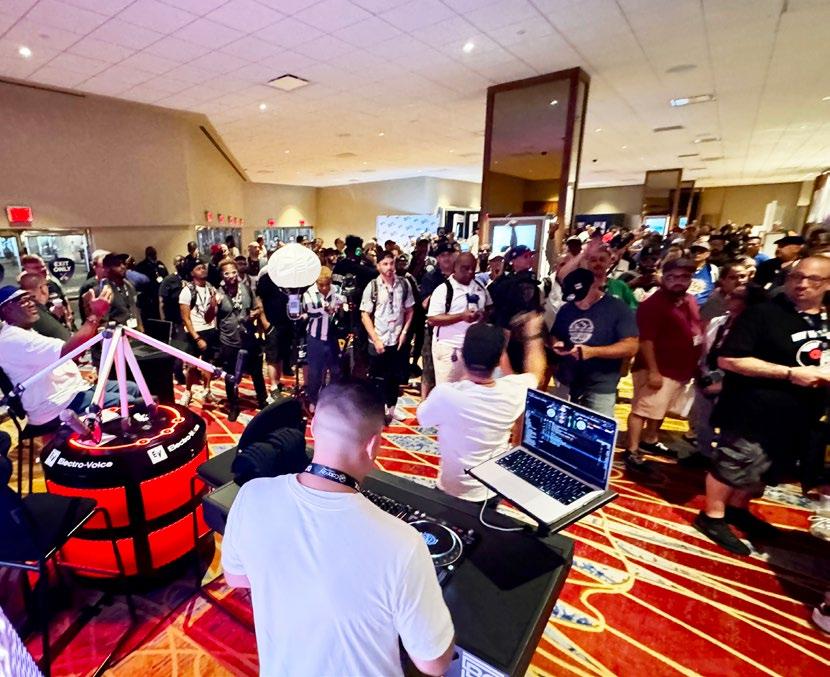


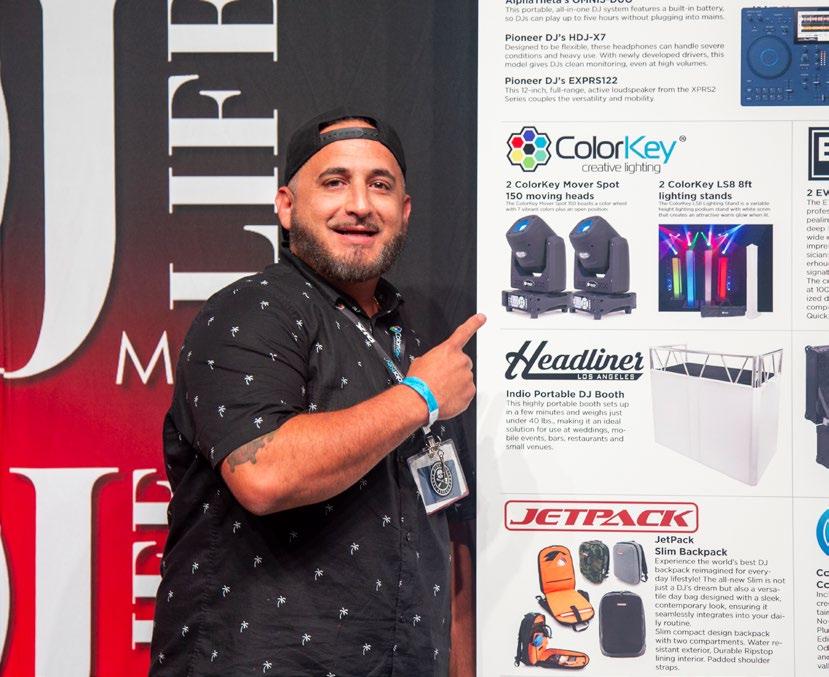


BY JIM TREMAYNE
s one of techno’s longest-running and most-respected DJ/artists, Dave Clarke has earned plenty of accolades over the years. Ever since he released the first of his three Red series EPs in 1994 and his Archive One album in 1996, genre-lovers have held him in high esteem.
Indeed, powerful tracks from those releases, like “Southside,” “No-One’s Driving,” “Wisdom to the Wise,” “Thunder” and others, have inspired techno jocks for more than three decades now. Perhaps most famously, the late BBC legend John Peel dubbed Clarke “The Baron of Techno,” still one of electronic music’s best handles.
Unfortunately, due to difficulties with Bush, one of the releases’ original labels, that hugely influential collection of music wasn’t available physically or digitally (including streaming) for more than 20 years. Second-hand copies were fetching big bucks, but original versions of the music were hard to find.
However, after “a decade of legalities,” Clarke and crew eventually retained the rights to the music and have made it all available to consumers and DJs alike. And as 30 years passed from the original Red release, Clarke teamed with Skint Records for a proper digital release and a special-edition box set of both the Red series and Archive One. It includes remastered original versions and bonus remixes (from Surgeon, Umek, Chemical Brothers, Robert Hood and more) in a one-time pressing, exclusive six-vinyl set slipcase box with a 16-page booklet authored by Clarke.
As he was preparing for his annual Dave Clarke Presents party on Oct. 18 during Amsterdam Dance Event, we caught up with the U.K.-born/Netherlandsbased DJ/producer, 56, to discuss this unique project and more.
DJ LIFE: Legalities aside for the moment, what was the experience of putting


together this 30th anniversary project like for you? As an artist revisiting his work and commenting on it with a 16-page booklet, what did you take from the entire process?
Dave Clarke: That sometimes time gives good perspective, when I made the music I hoped, but never expected, to make a career out of this. So, to revisit makes you think back to those shaky times, and now the word “techno” is bandied about by many who have no understanding or care. So, to release now feels like a book-
great remixes from terrific remixers with this project. The DJ Sneak [“Southside”] and Umek [“Wisdom to the Wise”] efforts really caught my ear. What was the process there?
Clarke: All the new remixes came by the artists themselves. They arrived over the years into my inbox, more as versions to play out, but when the project was reaching fruition it made perfect sense to include them. It really is an honor having your music gifted back to you in a remix by producers you respect.
mark, or more precisely two book ends. It gives a great perspective of how slow time can be, but at macro level how fast it was, too. My manager really should get a mention as I had put this behind me, all the negativity of trying to get my music back was compartmentalized, but thankfully he kept trying, and I really appreciate that and here we are now, and I’m once again incredibly proud of that album.
DJ LIFE: And it seems like the legal end of it was no picnic. Was there anything to learn from that experience? Any advice to other DJ/artists in a similar situation?
Clarke: If someone seeks attention by negative actions, just take it out your life, so I did; but also, seeing the perseverance of my manager made me realize that to delegate with trust can be a beautiful thing, too.
DJ LIFE: In the package, you’ve got quite a lineup of
DJ LIFE: In electronic music, a sound from 30 years ago can seem dated, or it can be a sound that’s gets revisited and enjoyed by the current generation. For me, a couple tracks brought me back to a time with some very particular sounds of the day – like “Thunder” – but others seemed to have a more timeless quality – like “Wisdom to the Wise.” Listening to these and the other original tracks all these years later, how did they strike you? Which ones go over best with audiences today?
Clarke: For me, they sound so very different to the techno that is being made today. The genre definitely changed through accessible production and software, but these tracks sound raw and a bit runaway with energy, plus Matt Colton’s remastering skills help them take advantage of modern sound systems. “Thunder” still is my favorite, though.
DJ LIFE: Dave Clarke Presents, your event business, seems to have been a great enterprise for you and its event has been playing ADE’s Friday night at Melkweg for years now. Not only do many of us look forward to your set in the main room, but you always bring a great group of other DJs to the party. How long has it been going on at Melkweg? What does that night, a prime spot during ADE week with so many visitors in town, mean to you?
Clarke: This will be the 19th year – hard to comprehend
actually. I was “offered” to switch to another location that finally did events at ADE after many years of no interest, but I wanted to stay at Melkweg for many reasons, namely its rock-n-roll heritage. Ironically, I played my second-ever Dutch gig here to support Archive One in 1995 or 1996. It didn’t work well at all, but now 19 years of it “working” makes me smile. I am always proud to do this event and support young talent, as well as those that stayed the course and true. I started when techno was a “hard sell” during ADE, and now when “techno” is not techno I still do it. I also have to thank all the different teams I have worked with over the years.
DJ LIFE: Can you name your three favorite nightclubs, living or dead, and tell us why?
Clarke: Sativa in Edinburgh, Scotland, then RedBox in Dublin, Ireland, and also Fabric in London. They are/were just real.
vinyl. It all started when I was 8, and I was hooked immediately.
DJ LIFE: In interviews and from asides you’ve made during ADE sessions you’ve moderated, you always seem to touch on the joys you’ve found with British punk and post-punk music, which isn’t something I hear much from other jocks. How have bands like The Damned inspired you and informed what you do as a DJ/artist?
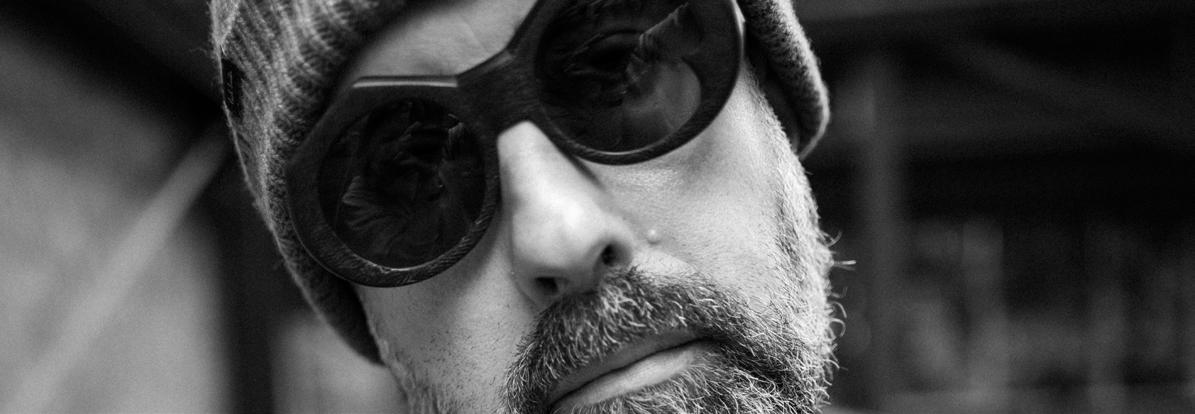
DJ LIFE: From your perspective, how has techno and its club scene evolved from the time of this project’s original release?
Clarke: It has lost the plot. Everyone does “techno” and every party is “techno,” but almost all of it is not techno, only about making money. They lost counterculture. They screwed its good name in turn for profit. It is mass-produced, mass-consumed utter shite. Respect to those that have kept it real – The Surgeons, The Luke Slaters. The ones that sucked and caressed minimal’s stinking balls started the rot, and it went downhill from there.
DJ LIFE: I last saw you play in the U.S. at the Detroit Movement festival a several years ago, but your visits to the U.S. have been few in recent times. Why?
Clarke: Bad drunken drivers, 30-percent tax receipts not forthcoming, other shady shit. It is a shame, as some gigs were great, including that Movement Festival. But, for me, it didn’t make sense anymore, especially by how commercial it all became… darn shame, as without the U.S., specifically Chicago, we would have no scene at all.
DJ LIFE: I really liked the “Charcoal Eyes” single with the late Mark Lanegan from a few years ago. It was quite a mixture – a tough, dark track matched with a voice like no other. Where did the idea of that unique collab come from? How do you remember that process with him?
Clarke: Mark, what a gentle man – spelt like that on purpose – such a talent, so lovely to be around, so real. This was the first time I truly wrote lyrics, the first time my heart was in my mouth when waiting for a reaction. He phoned up and told me he loved my lyrics. We just really hit it off. I miss him a lot, his talent and voice were unique.
DJ LIFE: What was your first musical memory as a kid? Was there a song, a performance or a moment that really knocked you out and drew your lasting attention?
Clarke: Ram Jam’s “Black Betty,” Gustav Holst’s The Planets , mucking around with tape machines and
Clarke: The Damned are still around – that says enough, right? Pure passion and integrity. This stuff opened my eyes in tonality and politics. I will always be grateful for that. Also the “do-it-yourself” attitude that was proliferated from punk/new wave and hip hop made you feel you could affect change through music.
DJ LIFE: How did you first get into DJing? Was there a DJ that inspired you?
Clarke: Kool DJ Herc – when I saw that, I knew where I had to be. Weirdly enough, Kenny Everett – he was wacky, but very clever with tape techniques. Of course, John Peel and Mike Allen. Then, in clubland, DJ Shem – first time I saw in the same physical space as me a DJ that could truly rock a pair of decks. I started “DJing” in my imagination at the age of 8 or 9 with a mono record deck and a tape machine.
DJ LIFE: What’s your DJ-gear evolution been like? What did you start with? What are you using now in the DJ booth?
Clarke: Mobile disco stuff, bouncy little record player with belt drives and tiny vari-speed. But that was after trying to use hi-fi decks, the Technics from 1987 to 2004. Then it was Technics “CDJs” with moving platters [SLDZ1200s], then Denon 12-inch moving platters – I helped in the design process for Denon for a few years, going to Japan, etc. Then, it was Pioneer DJ CDJs. First mixer would be a RadioShack battery-powered unit borrowed from a chemistry teacher, then lots of other mixers, like those from Citronic. Then it was Pioneer DJ DJM-500 all the way to the DJM-A9 today. I started using Serato round 2005. I stopped using it in clubs around 2020, but still use it for radio, and USB sticks.
DJ LIFE: Is there another technical development you’d like to see for DJs, something that hasn’t yet been realized?
Clarke: Yes, a talent filter, not an Instagram filter.
DJ LIFE: What’s next for you? What do we have to look forward to?
Clarke: My photography exhibition opens soon at The Leica Gallery in Amsterdam. It is called “In The Shatter Light” and it will be open throughout ADE.

By Jim Tremayne
Hollywood, Calif. – The Fourth Annual SKAM Summer Music Summit returned to Hollywood this past Aug. 19-20 with several sponsored activations, gear/technology demonstrations, and DJ-led parties. Presented by SKAM Artist talent agency, the annual conference

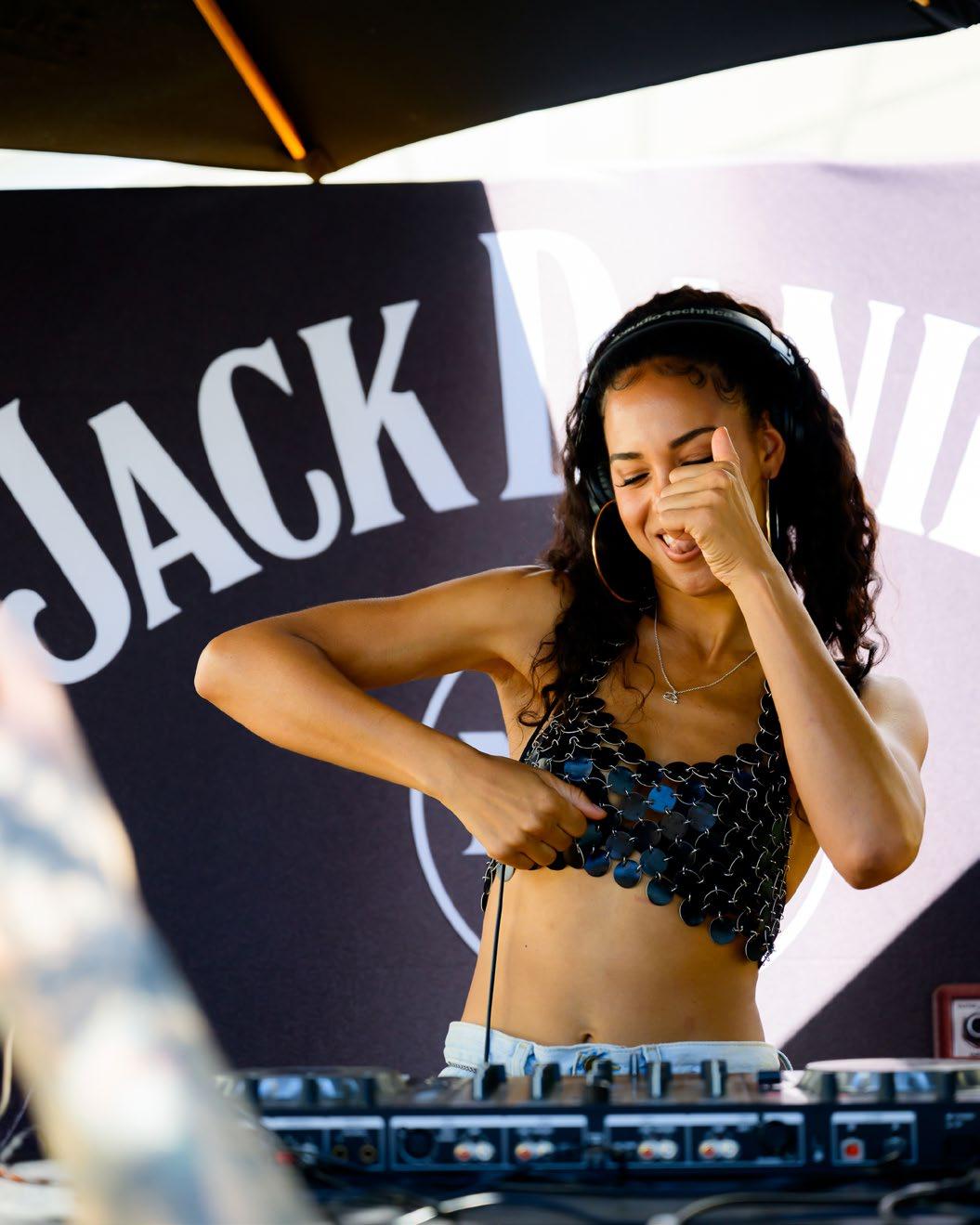
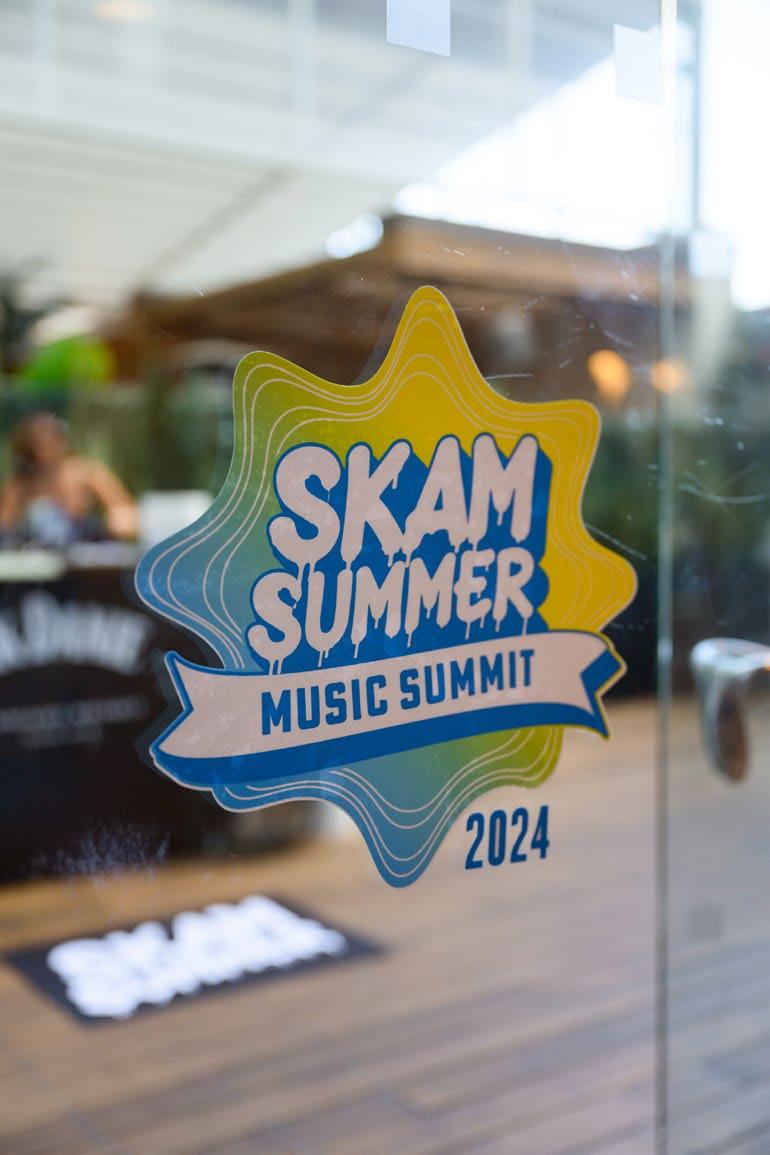


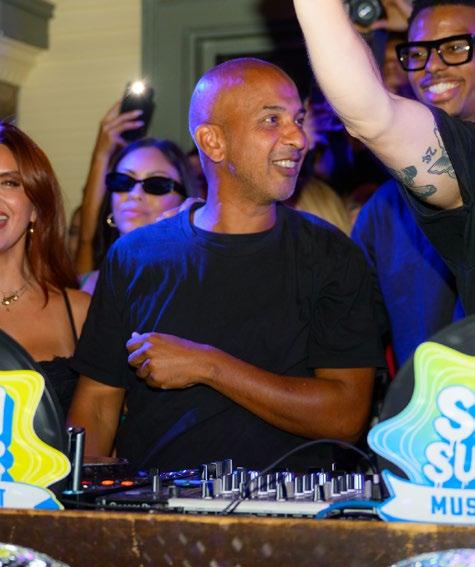

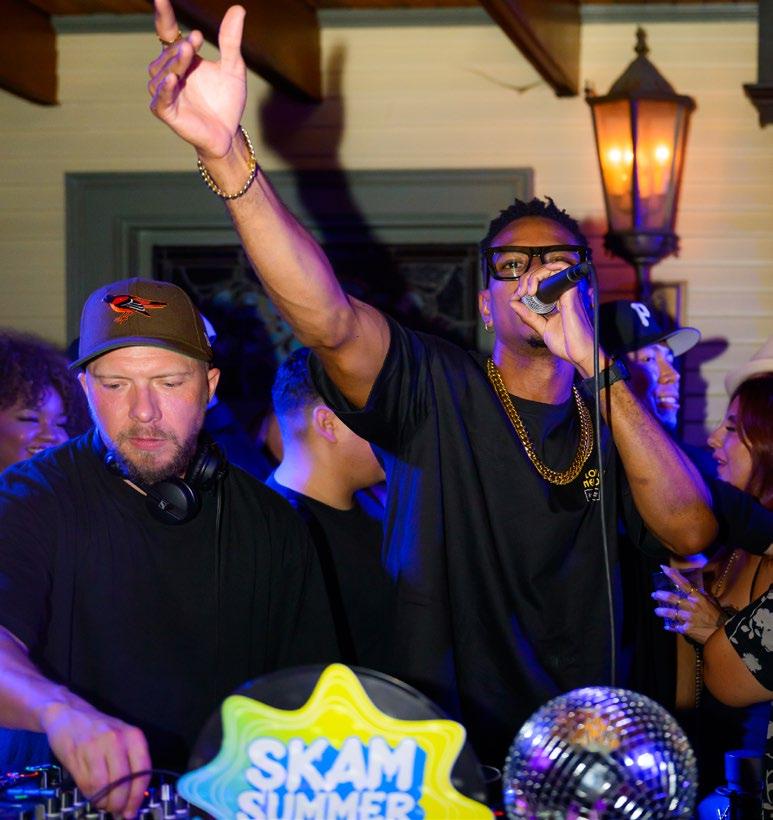




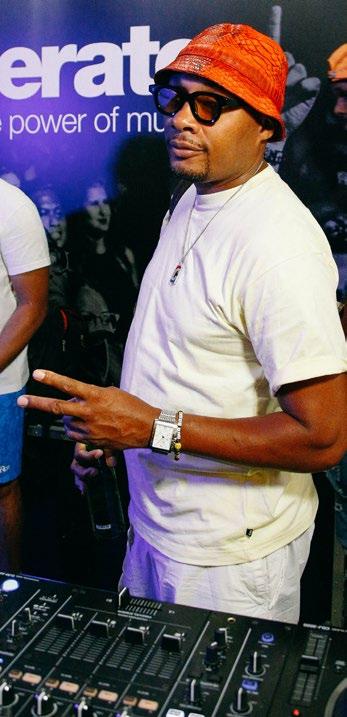

A fresh electronic music pairing between EDM mainstays LSDREAM and CloZee has resulted in an explosive new project, LSZEE.
Consisting of L.A.-based Sami Diament (aka LSDREAM, formerly Brillz) and French-born/Denver-based Chloé Herry (aka CloZee), LSZEE is already off to a soaring start, as they’ve released their eponymous self-titled debut album. In addition to the mind-bending full-length, an effort full of cinematic soundscapes, dizzying melodies, and crunching beats, the two have also secured some massive headline shows and major festival bookings for the remainder of the year and into 2025.
It was just revealed that LSZEE are among the top-billed artists performing at Ultra Music Festival’s 25th anniversary in Miami in March 2025, as per the event’s recent Phase One lineup announcement. This past Oct. 5-6, LSZEE’s two-night soldout events rocked the iconic Red Rocks Amphitheatre in Morrison, Col. And that pair of shows were followed by big gigs at Brooklyn Mirage, Florida’s Hulaween, and Philly’s HiJinx Festival, among other dates.
LSDREAM debuted in 2018, blending wobbling bass tones, hip-hop influenced beats, spacey and ethereal synths, and powerful lyrical messages. As of last October, in addition to his work with LSZEE, Diament’s LSDREAM project celebrated a highly-anticipated part 1 of a fourth studio album, Heartwave . The album was accompanied by a massive fall ’23 North American headline tour, The Radical Audio Visual Experience, which hit more than 35 states.
In 2020, CloZee began a new journey with the launch of her own artist-friendly label, Odyzey Music, where she pridefully highlights the underground artists of bass music and beyond. With this, Herry released CloZee’s sophomore album, Neon Jungle, which went on to see track remixes from the likes of Lane 8, Emancipator, Of the Trees, and Opiuo, to be followed by her 2021 EP, Nouvelle Era Odyzey Music went on to host stage takeovers for festivals like Electric Zoo, Sonic Bloom, and CloZee’s own Voyage Festival. And to top it off, her third LP, Microworlds, was released this past July. Along with the 12-track album came a coinciding 2023 North American fall
Mancino
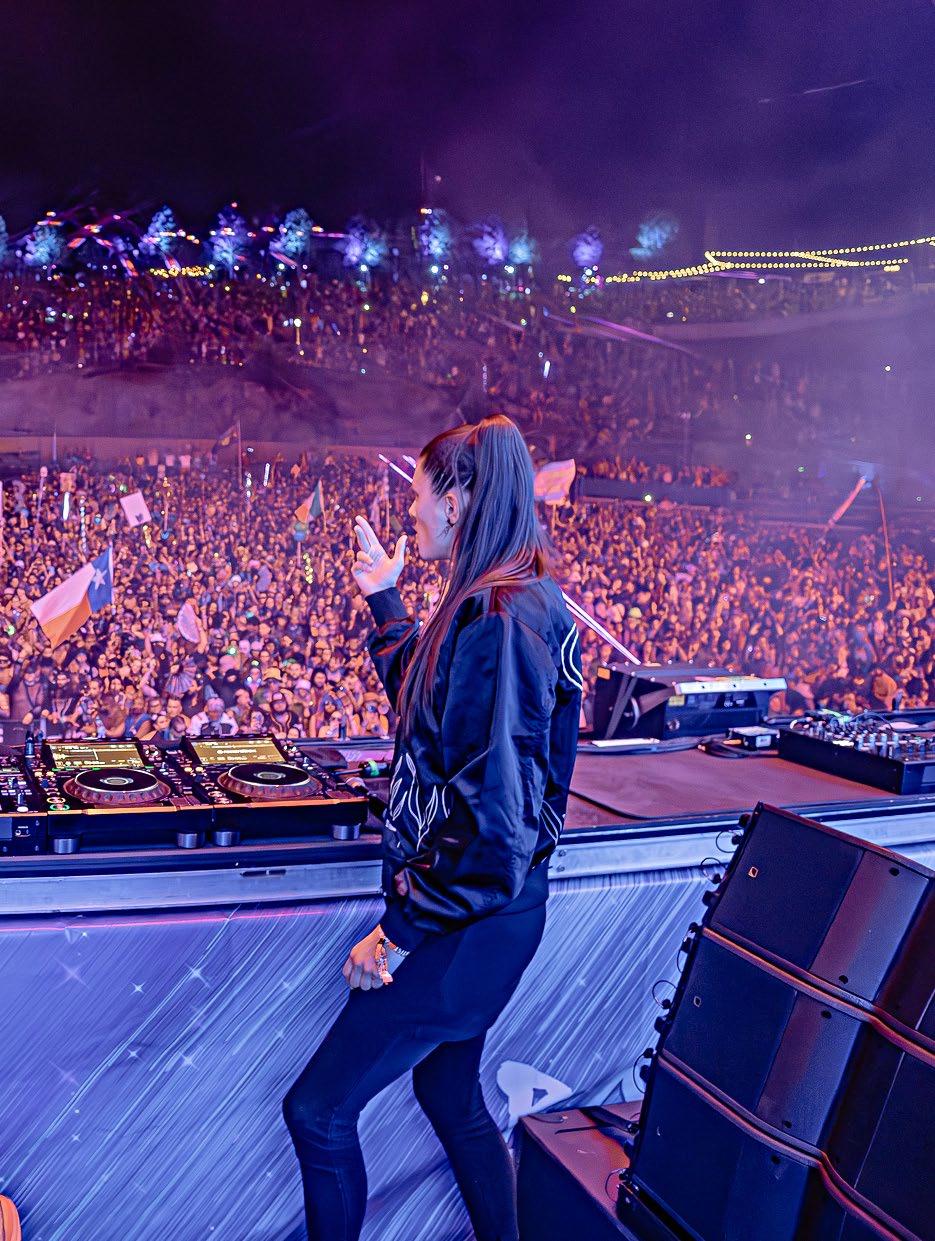
headline tour across 40 markets.
Following the late September release of their album, DJ LIFE caught up with Sami Diament and Chloé Herry to discuss all things LSZEE. It went down like this…
DJ LIFE: Walk us through a day in the studio when you’re together…
Chloé Herry: We are night owls, so we start going to the studio around 2 p.m. We eat a little food, drink some coffee, Yerbas… We usually tackle all the “admin” work in the afternoon to clear our minds, so that we can enter our creative bubble for the rest of the day. We are both similar in that way: we need space to get in the zone. We like working separately for some time to work on different songs, add our own ideas, emotions, and then we sit together to listen, share thoughts, bring new ideas, write new elements, have a coffee… We’ll repeat that process several times. Studio sessions typically end between 3 a.m. and 5 a.m. Then we like to wind down by playing PS5 or watch a movie.
DJ LIFE: What are some routines, rituals, or must-have items for your studio sessions, either as solo or joint sessions?
Sami Diament: Studio must-haves are coffee, good incense, a SubPac, our own laptops and set-ups in the same room, and PS5 to wind down at the end of a night. Need Postmates/Uber Eats or wouldn’t survive. Also, Discord to screen share and work on songs online when we couldn’t be together!
Herry: Music gear aside… the delicious coffees that Sami makes. I do love my wine and we’re both puppy owners, so there is always big puppy energy during our studio sessions.
DJ LIFE: How and when did you first realize this pairing would become an official project?
Herry: At first, we just wanted to work on a song together. We had no idea that the inspiration to write new music was gonna flow so naturally. We just kept starting songs after songs, and we just vibe with each other so well… so when that happens, you know there is something special going.
Diament: We did an Airbnb studio trip to Joshua Tree and lived out there for a week writing every day. I really admired Chloé’s work ethic, and most ultimate chill energy, it just felt effortless and fun to create together. The real conversation about what LSZEE would become happened there in Joshua Tree.
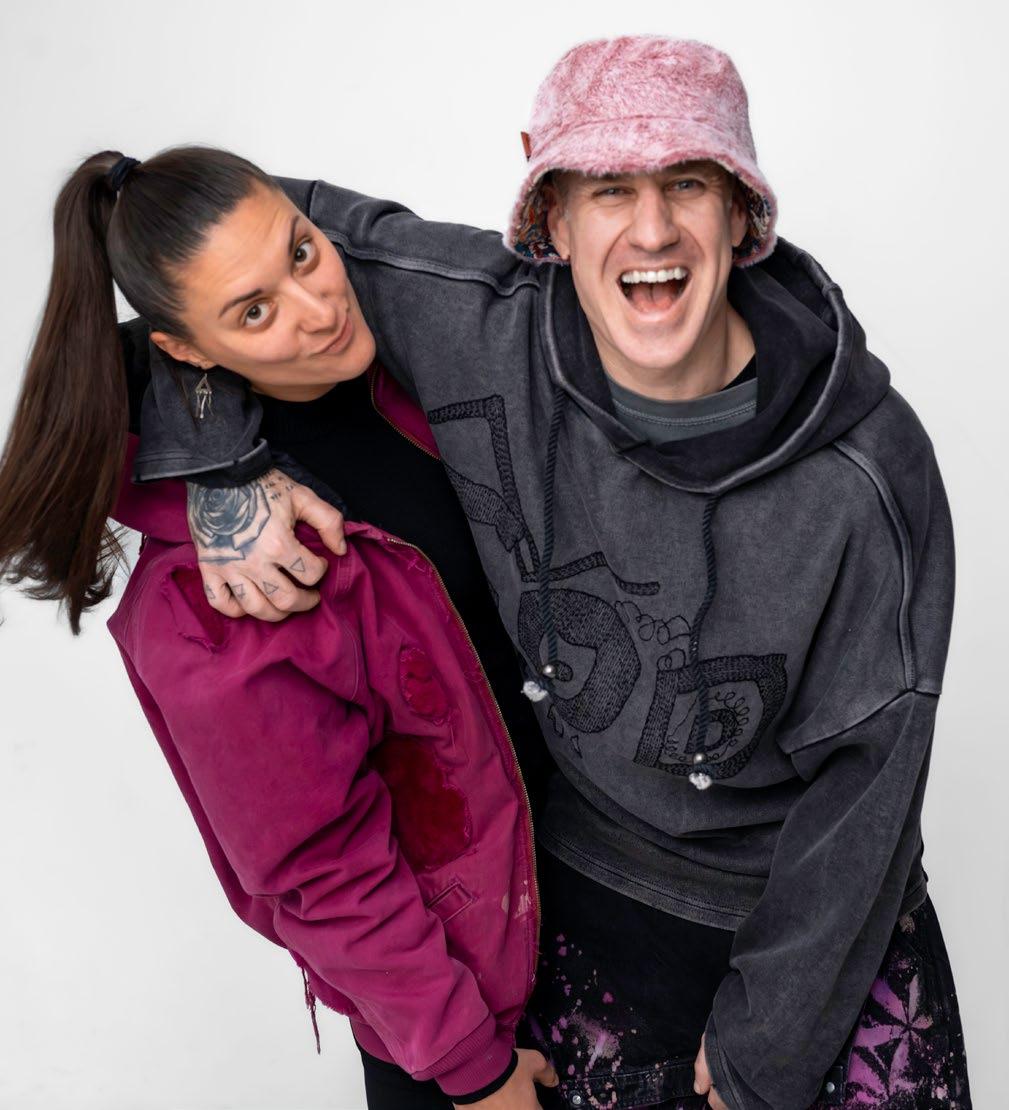
DJ LIFE: You’ve just dropped your self-titled collaborative album, what can you share with us about what made you decide work on a fulllength album together?
Diament: I love writing albums because a body of work allows you to tell a story, dig deep for ideas, and explore a lot of ground, musically speaking. Having the chance to do that with Chloé is a dream! I was always down to make an album, having it progress beyond that was truly an amazing surprise.
Herry: There was a moment when we started talking about doing a live show with all the music we wrote, and so the idea of an album, a project, a live show… it all come together at once.
DJ LIFE: Share a bit about the album-making process with us…
Diament: First step in the process for us was obviously writing a ton of music. The next step, which is something that always intrigues us, is identifying the story and theme that naturally wants to emerge and allowing it to grow from there. The final step is honoring what came out and finishing it! For the LSZEE album, the theme is exploration and discovery. Sometimes a song was created from
new sound-design journey, or using new plug-ins. Sometimes a song emerged by learning new techniques from each other, or making a song with a groove or BPM we don’t normally write in. Since we were constantly trading project files, you would always open it up and listen to what the other person did and discover the new elements and work the other person did, which would then lead you to where you wanted to take it. We decided to self-title it, cause its simply just about us collaborating. What we feel, who we are, what we made together.
DJ LIFE: The artwork for the LP is terrific. What can you tell us about it?
Herry: It was made by the genius Marko Slavkovic – @ Marhko_art on Instagram. We’ve been loving his art and thought it would capture the spirit of our music so well. It’s mystical, complex, psychedelic, captivating.
DJ LIFE: How do your DJ sets together differ from your solo sets?
Diament: The main difference is all the LSZEE exclusive material we made for the project. For example, we did mash-ups and remixes of some our solo material that we only play in a LSZEE set, and much of the original LSZEE music is only intended for those sets. In our solo projects, we tap into our own frequency, emotion, energy, so I think the combination of those elements in an LSZEE set, create a certain feeling and vibe neither of us cause achieve individually.
DJ LIFE: What are some of the pros and cons to working with a DJ partner or playing a B2B set?
Herry: Honestly, it’s been only pros. We uplift, support, inspire each other. Sami is an amazing human and we’re on the same page most of the time – except sometimes when we play games. We’re not imposing each other’s vision, or ideas, we respect each other’s music universes, and the LSZEE music is just a happy marriage between both of them. It’s also really fun and refreshing to share the stage with someone you’re close with. It makes these experiences so much more special.
Diament: The cons, for me, is being lowkey jealous of Chloé’s insane musically ability, the grace and beauty she brings to a track. I strive to be able to reach that level of talent.
DJ LIFE: As you gear up for major shows at top-tier venues such as Red Rocks and Brooklyn Mirage, what can you tell us about what fans can expect when seeing your DJ sets live?
Diament: Well, yes we are performing on Pioneer DJ CDJs, but we created something that extends beyond a DJ set. Our show is a fully curated music, visual, lighting, and laser experience. We are handson in every element of the show and work closely with our incredible team to bring our vision to life. For Red Rocks and Brooklyn Mirage, we are debuting an epic custom production element!
DJ LIFE: If you could bring in a third member as a special guest DJ for a set, who are some options you’d choose from and why?
Diament: If my dog Zeus – aka Fluffato – could DJ, he would already be in the group! Seriously, though, RJD2 – that would be insane.
Herry: Tough question. So many awesome DJs. But I think personally I’d love 20syl to be a third member.
DJ LIFE: Tell us what’s in store for the future of LSZEE…
Diament: More of everything! Really excited to share what we have planned next year when the time is right

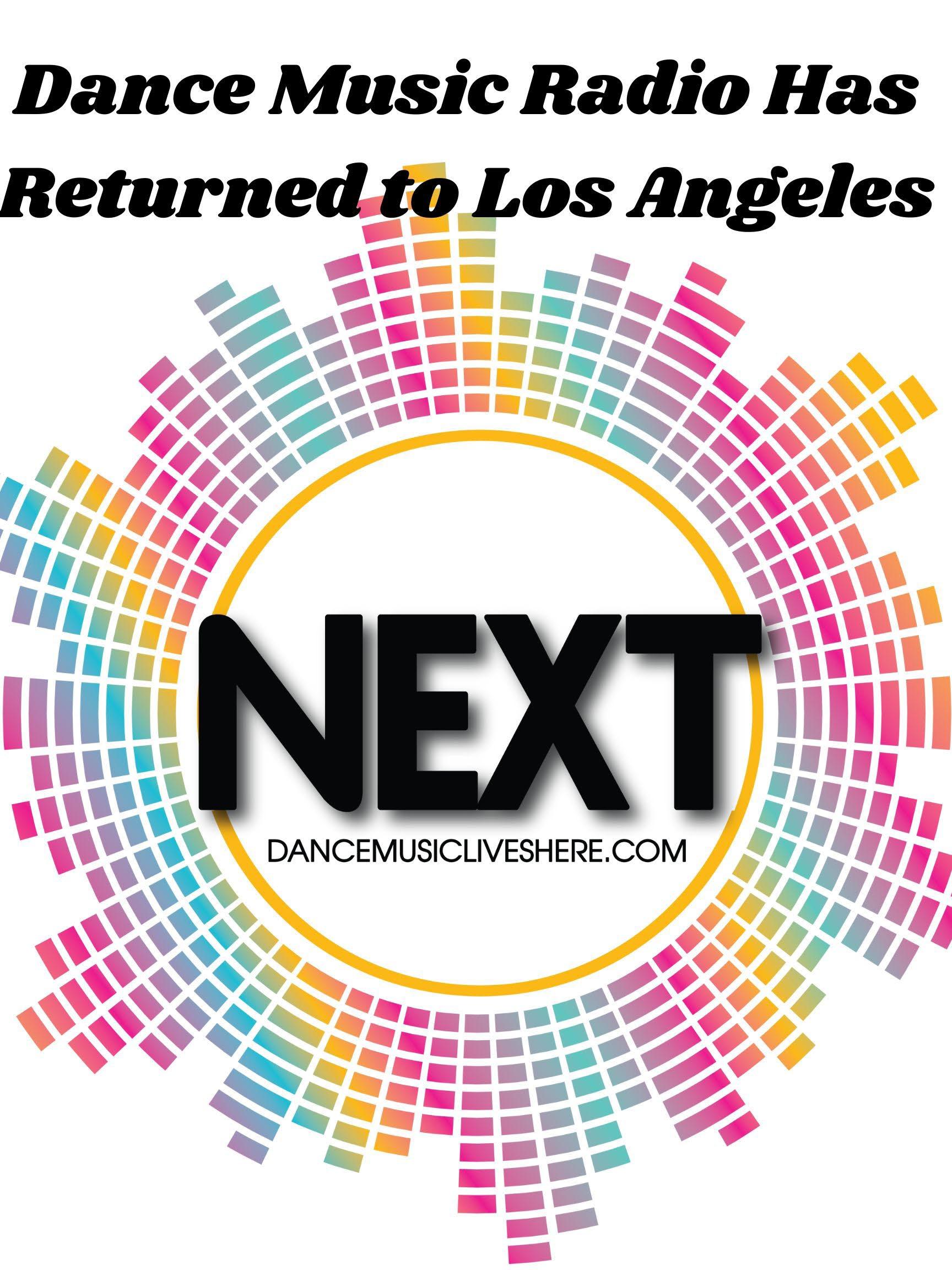
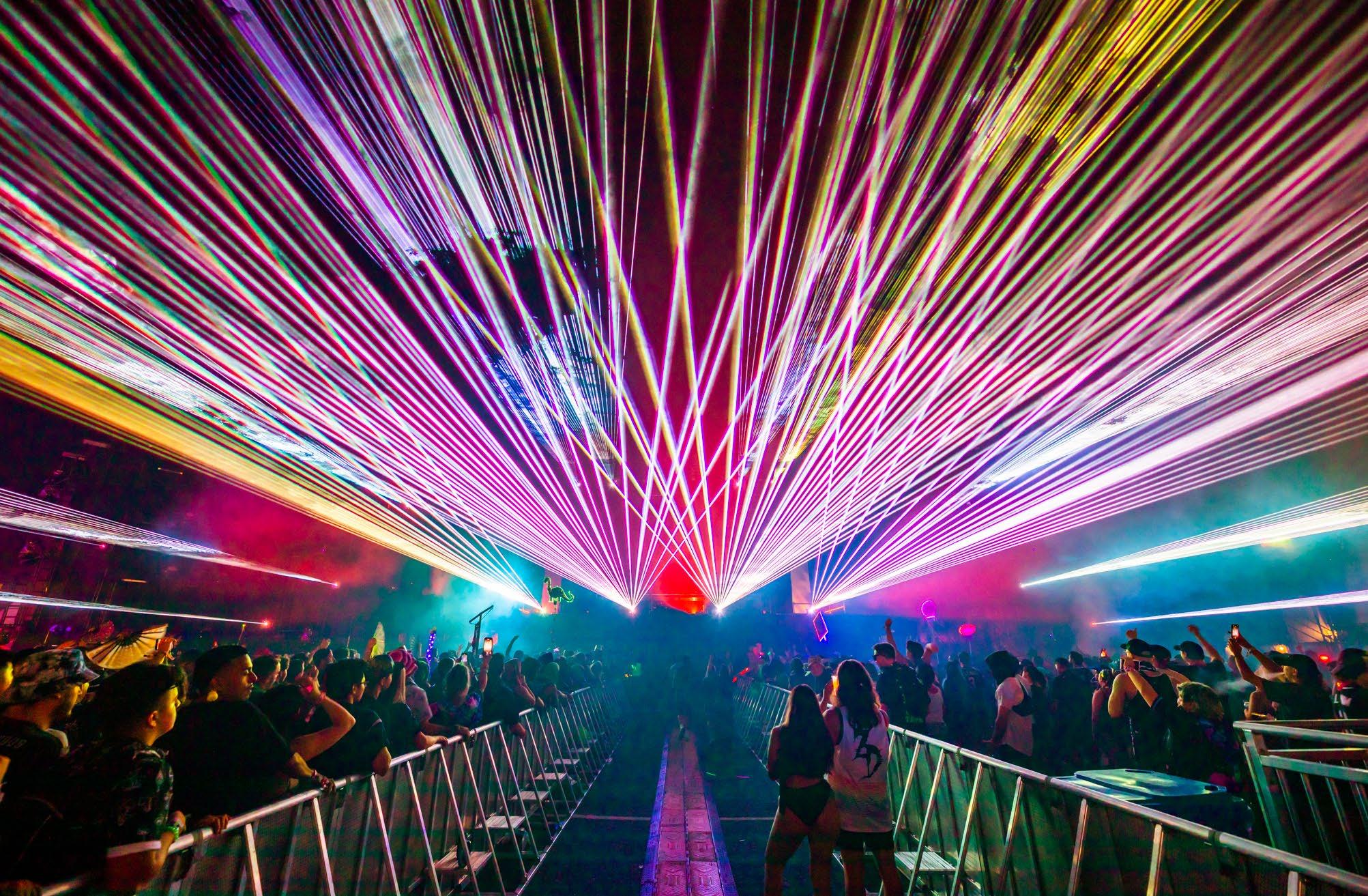
By Jim Tremayne
Bridgeview, Ill. – Some of the globe’s top EDM acts hit the Windy City this past Aug. 30 to Sept. 1 for North Coast Music Festival. Produced at SeatGeek Stadium in suburban Bridgeview, North Coast celebrated its 15 th anniversary with performances from the likes of Subtronics, Illenium, Seven Lions, Above & Beyond, Slander, LSZEE, ACraze and DJ Diesel (aka Shaquille O’Neal). It all looked like this:


Mid-Air: ISOKNOCK spins above the crowd. Divisuals

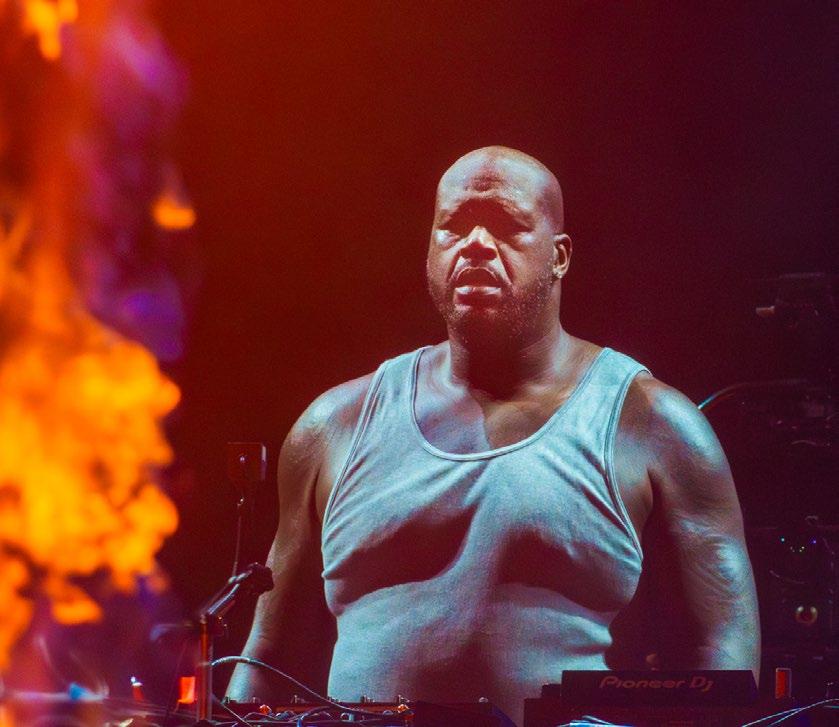
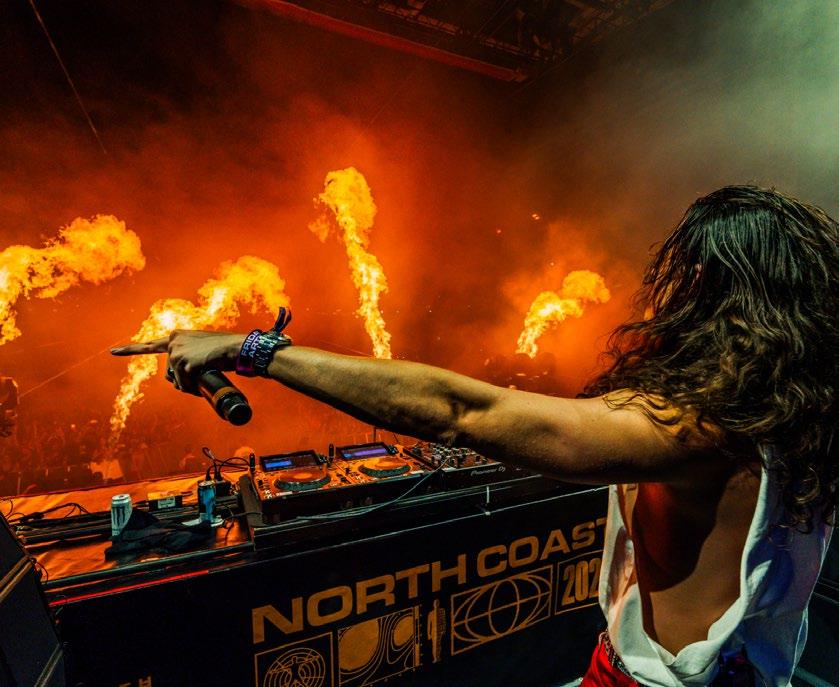



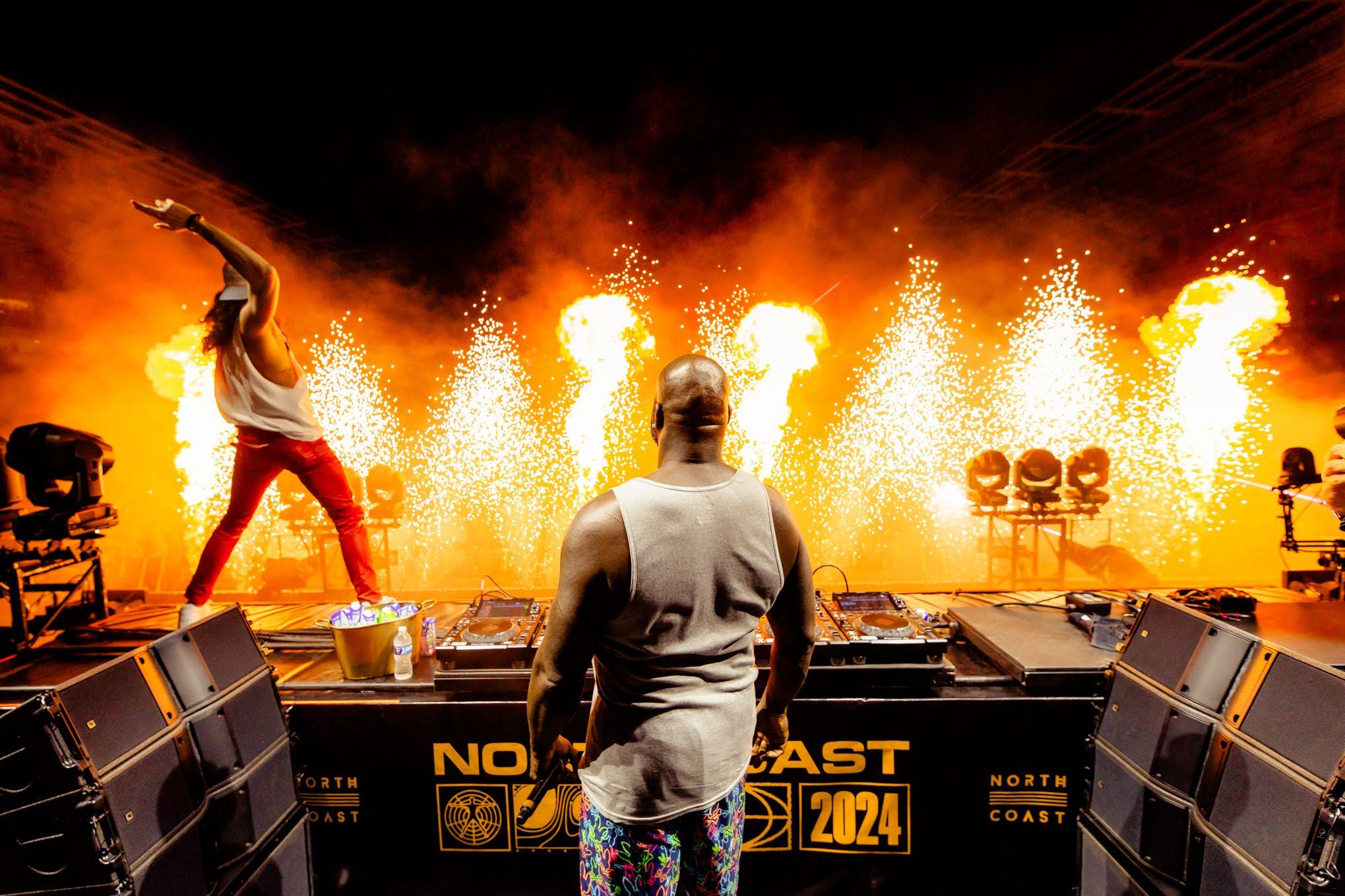


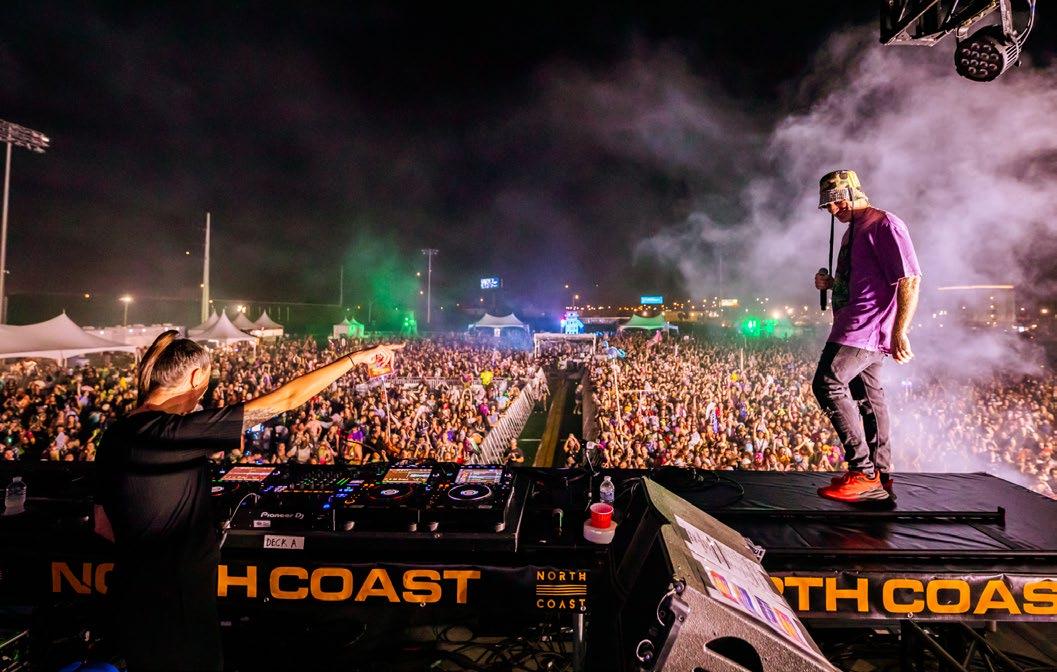

By DJ Deets & Wesley King
This month’s Playback column features two reviews. Minnesota’s DJ Deets handles AlphaTheta’s new rotary mixer – the euphonia. Meanwhile Colorado’s Wesley King tests out Sensaphonics’ sound-level analyzer – the dB Check Pro.
If you look around the DJ market, you might say that the industry is in the midst of a rotary-mixer renaissance. Major brands have entered the fray, competing with a seemingly endless number of offerings from boutique manufacturers.
Notably, AlphaTheta – the brand closely affiliated with Pioneer DJ – recently launched the euphonia, a $3,799 monster with the singular goal of becoming rotary royalty. I recently got the chance to get my hands on a euphonia unit, and here’s what I thought:

Look & Layout: For starters, the euphonia is visually stunning. It has a black finish highlighted by copper/rose-gold accents on the major knobs. Two dark-wood panels on the side add additional visual flare. It’s very industrial chic and would look right at home as part of a high-end audiophile setup or next to various pieces of studio gear.
Let’s break down the layout: the euphonia has two levels. The top level has a large three-frequency isolator, the effects section, the master level knob, and a bright screen (more on that later). The three-band isolator has individual knobs for low/mid/high frequencies, and each frequency has a dedicated Send button for effects. A Note: Although very large and great to use, the isolator knobs don’t click at the center position, which is something I would have liked to see.
The effects section has a few in-built effects and the ability to send and return signal through any external effects device. A notable omission from the effects section is a low-pass filter (something I find myself using a lot while performing). Additionally, I could not find a way to run multiple different effects on multiple channels – like what you can do with individual channel-level high/low pass filters. I may have gotten a little too accustomed to having individual channel filter controls, so I find myself missing that functionality here
Below the effects section is a color screen that AlphaTheta calls an “Energy Visualizer.” The screen shows detailed levels for each channel on a simulated needle gauge (in addition to the physical VU meters on each channel), as well as the master level. Pressing the View button brings up a detailed view showing any active effects. Long-pressing the View button opens the utility menu. FYI, it’s not a touch screen; when I first got my review unit, I made the mistake of trying to tap
the screen expecting something to happen. It’s not a big deal by any measure, but worth pointing out.
The lower level has the traditional channel controls, headphone controls, microphone controls, and the booth level and equalizer. Each channel contains the usual fare (threeband EQ, trim control, VU meters, headphone cueing) plus a send/return knob to send an individual channel to the effects section.
Rotary Faders: Now, let’s get to the centerpiece of the euphonia: the rotary controls. These are among some of the best rotary faders I’ve ever used. AlphaTheta says there’s a special system that allows the knob to provide different levels of resistance depending on how quickly and forcefully it is turned. It’s buttery smooth and a joy to work with. I can hope that they will still feel as satisfying after years of heavy use. All the special faders have a nice, scalloped, rubberized side and a shiny copper/rose-gold top.
There are two headphone jacks – one on 1/8-inch and one on ¼-inch. Some mixers have started adding two separate headphone-cue circuits, and I am curious if any users will find themselves missing that functionality here. There’s an option for mono split-cue or stereo cueing as well. There’s a dedicated booth level with its own EQ functionality (high/ low) and a mic input with its own high/low EQ controls.
On the back, you’ll find all the usual ins-and-outs. There are separate RCA phono and line-level inputs for each channel, as well as digital inputs for each channel. The master output is on XLRs, and there’s a record output on RCAs. All the effects send-and-returns run on TRS jacks, and the mic input is a combo XLR/TRS input. There are two turntable grounding plugs, and a USB-C for connecting the mixer to a computer. Finally, power comes in via a lockable IEC cable. Ear Test: Simply put, the euphonia sounds great. Alpha-
Theta worked with Rupert Neve Designs to design special circuitry for the mixer, and it shows. They describe the sound as “glossy and energetic,” and I definitely agree. Conclusions: Who might the euphonia be aimed at? It’s not exactly affordable – it is easily one of the most expensive mixers on the market. Nonetheless, I could see this being purchased as a studio tool for big-name DJs who mix
Sensaphonics dB Check Pro
Anyone who’s read my reviews and articles in the DJ and pro audio space over the years knows that I care deeply about hearing protection. For DJs and other professional performing musicians, the ability to hear is mission-critical to the artform. And yet, loud music and noise are occupational hazards that have to be taken very seriously.
The problem, however, is that even when you use solutions, such as professionally fitted IEMs with excellent passive ambient noise reduction, you still have a risk: Turning up the sound so high that you potentially cause as much hearing damage as not using a monitoring solution with passive reduction to begin with.
Sensaphonics, the Chicago-based manufacturer and retailer of custom IEMs, earplugs, and other audio solutions recently rolled out a very intriguing solution to this particular “second-tier” problem. That solution? The Sensaphonics dB Check Pro sound-level analyzer.
The Basics: The dB Check Pro is a clever accessory for IEM users that can be worn on a belt or slipped into a pocket, and goes in-line between the audio source, and your IEMs or headphones. With a color display and onboard software, the device displays a range of details about your audio levels, including the fundamental “how loud, how long” parameters that get right to the very core of the issue.
To achieve this feat, Sensaphonics compiled data on over 140 different IEMs and headphones – not just with Sensaphonics’ own IEMs, but across 12 major brands in the market, including my day-to-day custom IEMs from Ultimate Ears Pro, along with Westone and others. These analyses, coupled with the device’s ability to measure the signal level of the audio stream, allows the dB Check Pro to accurately calculate sound pressure from the signal itself, and provide safe exposure times under both NIOSH (National Institute for Occupational Safety and Health) and OSHA (Occupational Safety and Health Administration) guidelines.
Beyond the monitored stream, the dB Check Pro also leverages an onboard microphone that enables it to show level information for ambient sound in the environment as well. It’s a clever solution to an otherwise difficult challenge.
In Use: Setting up the dB Check Pro is extraordinarily simple. With the unit’s internal battery fully charged, turn the unit on, and use the pressure-sensitive screen to select the make and model of your IEMs or headphones. Set the desired averaging time, and whether you want to see information about your listening device, the ambient sound levels, or both. Then, connect the sound source to one of the two jacks on the unit, and your IEMs or headphones into the other. Turn on your audio, and take in what the screen of the device has to say about your monitoring environment and levels. An integrated belt clip is a handy way to keep the device inline and handy during a listening or performing session.
house and techno styles of music. Clubs that regularly host these kinds of DJs and events (or rental houses that support these venues and DJs) could also look at picking one up to have on inventory. High-end home DJs whose mixing styles are conducive to the rotary mixer workflow may also be considering this mixer. For the proper application, I must say this is simply a killer unit.
Two icons on the screen of the device allow you some control over the experience. One allows you to pause or resume audio level averaging for your session, while the other will end the session; a second press clears the display.
Perhaps the most valuable information the dB Check Pro provides is an allowable-exposure-time display, based on the current sound levels.
There are two — one based on NIOSH guidelines, and the other on OSHA guidelines. NIOSH is the more conservative of the two, and Sensaphonics strongly recommends using the NIOSH exposure times as your guide. Shown in hours and minutes, it provides a simple, easy-tounderstand “not-toexceed” guideline to avoid the potential for permanent hearing damage.
Perhaps, obviously, you can extend your not-to-exceed time by simply turning your audio levels down to align with the duration of your performance or monitoring session.

Depending on your own preexisting hearing acuity, you might find yourself a bit surprised at the numbers displayed by the unit; I know I was. It doesn’t take as long as you might think at seemingly appropriate volume levels to get into the potential danger zone. That, in fact, is the entire point of the dB Check Pro… If you take your hearing health seriously, you’d do well to heed the unit’s advice, and tame your monitoring levels accordingly.
Conclusions: This level of intelligence and hearing protection doesn’t come cheap, however; the dB Check Pro runs $500. For that investment, you get the unit itself, a hard-shell case, USB-C charging cable, and an audio jumper cable. Is it worth it? I suppose the answer depends on just how important your hearing is to you. To be sure, it takes the guesswork out of equation, and provides insight that you just can’t get any other way.
For those of us who’ve invested in the custom IEM ecosystem — and it is an investment in and of itself — it feels like the dB Check Pro is just rounding out that investment, and the hearing protection benefits that come along with it.

By Wesley King
Over the years, I’ve reviewed a lot of studio monitors, and of all the DJ and studio gear that I review, monitors are among the trickiest because it’s unusually challenging to be objective about them.
I once thought that a lab full of the right equipment might be the ticket to objectivity with monitor evaluation, but I no longer think even that would counter a what I’ve come to see as a basic truth: How a monitor sounds is contextual, subjective, and affected by a nearly infinite number of variables that are impossible to fully normalize. But once again, I’m going to give it the old college try, as they say. And the target of this effort? The Focal Alpha 80 Evo studio monitor.
Prior to this review, I must confess that Focal just wasn’t a brand I paid much attention to, in large part because they’ve occupied a premium segment of the market. One could argue that they still do. But the French company has spread its wings (and product range) a bit, opting to assemble the Alpha Evo series in China (to reduce costs), rather than in France. That said, the company makes the drivers for the Alpha Evo line in France, just as it does for its higher-end lines, allowing it keep production of these key components close to its engineering teams.
Focal products typically represent a high level of traditional craftsmanship. With offerings ranging from premium home audio and home theater to audio solutions for commercial establishments, if there’s a place to put a speaker, the company probably makes one that can go there. Some of the offerings are as much aesthetic as functional; the company maintains a high-end cabinetry workshop that turns out speaker cabinets for some of its products that are truly works of art.

For studio monitors, the company makes products across several different lines, with corresponding market segments. To give you some idea of where things sit — picking at random here – the 6.5-inch ST6 series monitors go for
about $1,500 a pop, while the 6.5-inch option in the Shape line runs $900 each. Meanwhile, the Alpha 65 Evo 6.5-inch units are $400 each. That should give you a sense of how these things are positioned relative to their affordability. With assembly offshored, and with more basic speaker cabinets, the Alpha Evo line is designed to more readily compete with other more mainstream choices on the market. This puts them within reach of many home-studio users, as well as professional studios looking options that don’t break the bank.
For this review, I received a pair of Alpha 80 Evo units to check out — the largest of a family which also includes 5-inch and 6.5-inch versions, as well as a twin-unit option, and a subwoofer. I’ll drop a spoiler right here at the start: Hooking them up in my studio and disabling my Sonarworks SoundID Reference room-correction software, I queued up a few of my favorite tunes, the sort of stuff you know like the back of your hand. And to be honest? I was absolutely blown away… so much so that I felt I had to try and get to the bottom of my immediate reaction, which is, honestly, where things start to get difficult.
Studio monitors are arguably designed to be flat and true, “flat” meaning that the speakers reproduce sound at a consistent level across the entire frequency response range without coloration. When I first got into this, I naively believed that all other issues aside, if a monitor were truly flat, then it wouldn’t stand out against its competitors. These days, I understand it’s just not that simple, and it makes it difficult to pinpoint what sets one option apart from another.
For context, I always use the aforementioned SoundID Reference room-correction system with my studio monitors. A calibrated microphone and a sophisticated analysis process are used to create a profile of actual performance from the listening position in your studio – taking into account any absorptions and reflections inherent to the room and its furnishings. Then, in software, corrections are applied to the audio that’s fed to the speakers, flattening out any frequency-response peaks or valleys.
But as I mentioned earlier, this doesn’t eliminate all the differences between monitors – and it’s not supposed to. Apart from frequency response, how a speaker sounds and how well it reproduces sound has myriad variables. It’s ability to accurately reproduce full-spectrum sound is one variable; does a stretch of a song with deep bass affect how the midrange sounds are reproduced? That’s only one example; the design and implementation of the onboard amplifiers play a role in the sound, as does the cabinet size and design, crossovers for frequency overlap between drivers, the size of the main driver(s), and the design and construction of the drivers themselves. And of course, the price points involved can qualitatively affect any of these elements, too.
In truth, even affordable monitors with small drivers can be impressive; I have a pair of major-name monitors with tiny 4-inch main drivers, and wall-mounted with brackets and properly aimed, they sound incredible. Deep low-end? No, but they provide a terrific listening experience, nevertheless. In short, things are not always as they appear.
But back to the Alpha 80 Evos… To start, they do have a nice big 8-inch main driver that’s specified to go down to 38 Hz. (For comparison, Focal’s dedicated Alpha Evo subwoofer is rated down to 32 Hz — not massively lower.) And indeed, these monitors have a mighty nice punch at the low end. But that punch doesn’t come at the expense of the rest of the spectrum; the crispness, clarity, and presence of the sound reproduction from the Alpha 80 Evo units is simply remarkable. (If Focal’s “low-end” offering sounds this good, I’d love to hear a pair of their Trio6 monitors someday… to the tune of $3,500 each .)
In terms of aesthetics, to be sure, the Focal Alpha 80 Evo monitors may not come out of the company’s cabinetry workshop in France, but they still have an appealing look. Using a combination of wood composites and plastic laminates, along with molded plastic panels, they have a fresh, modern aesthetic that adds a nice touch to any studio. Even the black-painted fasteners used to put everything together adds a nice visual touch.
On the front, you’ll see Focal’s 1-inch inverted dome tweeter, and 8-inch so-called “Slatefiber” membrane main driver, along with the bass port at the bottom. On the back side, you get the full complement of connections: XLR, balanced ¼-inch, and RCA (unbalanced, of course). A sensitivity switch, auto standby on/off switch, and power switch are present, along with both low and high shelving adjustment pots. Inside are a pair of Class D amps: 35 watts for the high end, and 80 watts for midrange and below.
Without doubt, compared to other monitors I’ve recently used, they’re monsters, standing a bit over 15-inches high, and are around 13-inches deep, and nearly 12-inches wide. They also tip the scales at nearly 22 pounds. Of course, their size is also part of the formula for why they sound great.
Loading up Ableton Live and giving a listen to some random projects of mine felt like it brought a little extra life to material I’m intimately familiar with. As I mentioned earlier, listening to a wide range of my favorite music across various genres left me impressed. And focusing in on some favorite EDM tracks with thundering low end, I didn’t notice any compromises in the midrange in the process, either.
Monitors may come in numerous sizes, with numerous configurations, and at numerous price points. My general advice is always to stick with established names in the market and choose something with the largest main drivers you can afford (and/or find room for). Then, do your homework, check reviews, and demo your options if you can. (It’s more difficult these days, admittedly, as brickand-mortar options for pro audio have thinned out).
But, at $499 per unit, choosing the Focal Alpha 80 Evo means an investment of around a grand for a pair of them, and no, that’s not peanuts. But with 115 watts of total power, max SPL of 106db for plenty of headroom, ample frequency response of 38Hz to 22kHz, and killer sound? Well, I can’t imagine anyone making that investment will come away disappointed.

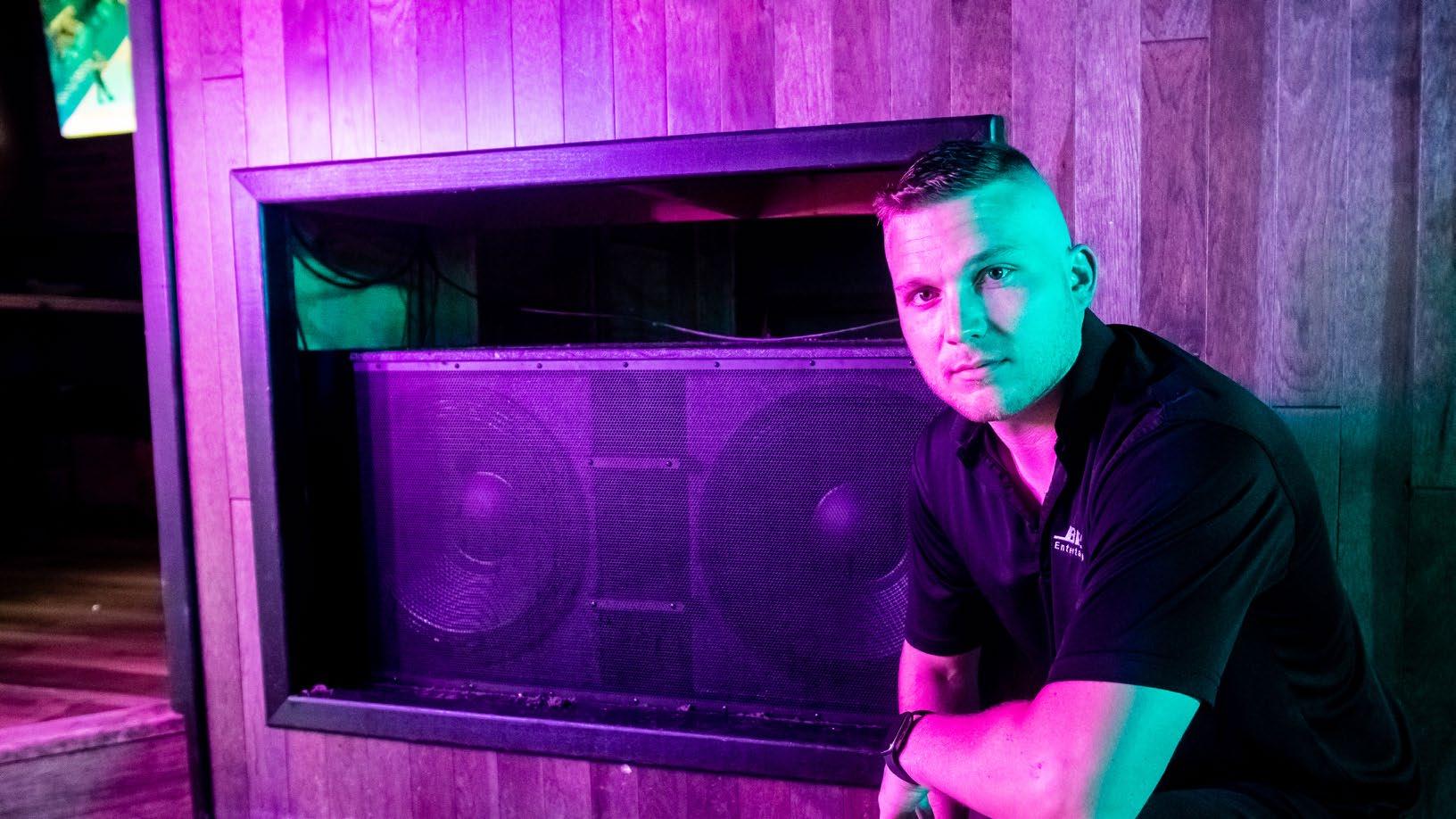
Holland, Mich. – When Matt Besemer finally started his own DJ business in 2020, he didn’t realize what further opportunities lay ahead of him. Not only would he be booking and playing his own gigs, he’d be hiring help – and eventually he’d be installing and renting pro-audio gear.
With its hybrid approach, BES Entertainment has created a unique space in the West Michigan market. Serving a metro area of more than a million, BES plays a variety of events, while also renting and installing lighting-andsound systems statewide. An official dealer of BASSBOSS systems and more, BES has tapped into several revenue streams and foresees a bright future. We caught up with Besemer, 34, to discuss his business.
DJ LIFE: What got you started with music?
Besemer: I grew up in the small town of Greenville, Mich., and music has always been a significant part of my life; I can’t remember a time when I wasn’t fascinated by it. As a young teenager, my parents gifted me an iPod for Christmas. Whenever I heard a song I liked, I would dive deep into the artist’s discography, often downloading entire albums. Back then, platforms like LimeWire, which may or may not have been involved, made it possible for me to explore music affordably. In high
school, I was that kid with the car stereo you could hear from a mile away.
DJ LIFE: What about clubs and that kind of music?
Besemer: At 18, a friend introduced me to the nightclub scene. While I wasn’t much into dancing, I was captivated by the loud music, the lights, and the overall atmosphere. I vividly remember being blown away when a DJ explained Serato Scratch Live to me – the concept of digital vinyl was mind-blowing at the time. After that conversation, I turned to my friend and said, “I could do that.” A few months later, I saved up enough to purchase an SL1 kit and some Stanton turntables, and that’s where my DJ journey began.
DJ LIFE: How did the gigs start?
Besemer: During my college years at Central Michigan University, a friend who worked at a hookah lounge called me one night – their DJ was a no-show. Knowing I dabbled in DJing, he asked if I could fill in. Initially, I declined because performing in front of strangers was a terrifying idea. But when he mentioned I’d be paid $50. I thought, “That’s a lot of beer money,” and decided to give it a shot.
DJ LIFE: How’d it go?
Besemer: To my surprise, the crowd was incredibly supportive. By the
peak of the night, there was a line out the door. Hearing a crowd of strangers cheering for the music I was playing hooked me instantly. That one gig turned into a weekly residency, then another, and soon I was DJing three nights a week, making $450 cash every weekend – a significant amount for a college student.
DJ LIFE: How did that grow into what you’re doing now?
Besemer: One of the nightclubs I worked at hosted big-name DJ acts. The production company they hired also managed a team of mobile DJs and occasionally needed extra hands. I started helping them out and learned how to DJ and MC weddings. I stayed with that mobile DJ company part-time for over a decade, working 20 to 30 weddings per year. However, my nightclub background in beatmixing and quick transitions often set expectations that the other DJs within the company couldn’t consistently meet. After being asked several times to dial things back, I realized it was time to move on. In January 2020, I officially launched BES Entertainment LLC.
DJ LIFE: How did you get into the installation business?
Besemer: During the pandemic, a friend and club owner reached out for help renovating his nightclub’s
lighting system. On a tight budget, I leveraged my DJ and project-management experience to design, procure, integrate, and program a new lighting rig. He was so pleased that he had me overhaul their sound system, as well. Word spread, and soon I was approached by other college bars for sound-and-lighting integrations. What began as a favor evolved into expanding BES Entertainment into, not just a mobile DJ service, but also an installation-and-integration company for production equipment.
DJ LIFE: How many events do you do each year?
Besemer: I spin just over 40 events per year and we average just over 100 events per year. I currently have one full-time DJ and two part-time DJs on staff.
DJ LIFE: What’s your percentage breakdown of events?
Besemer: Based on our 2024 calendar data: 59-percent weddings; 20-percent mobile productions; 10-percent bar/club performances; 4-percent corporate events; 4-percent school dances; and 3-percent wedding anniversaries.
DJ LIFE: What’s your market like now?
Besemer: Our local DJ market is evolving, with a noticeable decline in budget-DJ services and a higher demand for premium offerings. Clients are seeking DJs who can transform their events into personalized nightclub experiences. With music-streaming services making it easy for clients to handle background music themselves, there’s a growing demand for skilled DJs who bring genuine talent and energy to events. In the Holland area, we see a significant influx of weddings during the fall, as couples are drawn to the cooler weather and vibrant fall colors for their photos. Additionally, the Lake Michigan Lakeshore attracts destination weddings, with friends and families traveling to experience West Michigan’s beautiful outdoors.
DJ LIFE: What makes your company unique within the market?
Besemer: What sets us apart is our dedication to the DJ craft and providing an unparalleled experience. Every member of my team has extensive and notable backgrounds in the local bar and nightclub scene. When you hire us, you’re not just getting a DJ – you’re hiring an elite, professional,

open-format DJ and career entertainer. Moreover, we’ve invested heavily in how we’re heard on the dancefloor. In 2023, we overhauled our entire operation with BASSBOSS sound equipment, enhancing that nightclub-esque experience for our clients.
DJ LIFE: For rentals, what’s that business like?
Besemer: Our most common rental clients are event promoters needing to fulfill touring artists’ technical rider and backline requirements. Our rental inventory includes approximately $100,000 worth of BASSBOSS equipment, as we are an official BASSBOSS dealer. Our most popular BASSBOSS rentals include AT212 tops, VS21 subs, BB15 subs, and CCM monitors. For DJs, it’s all Pioneer DJ gear. For digital and analog mixers, we have Allen & Heath, Behringer and Yamaha. For wireless, it’s Shure and Sennheiser.
DJ LIFE: When it comes to installations, how many do you do a year?
Besemer: This year, we’ve worked with 12 different venues of varying capacities – schools, coffee shops, event venues, bars, and nightclubs. Our primary clients tend to be college bars and nightclubs, which demand robust and reliable sound and lighting systems. Understanding their unique needs requires experience and strong industry connections.
DJ LIFE: How does your company market itself?
Besemer: For our integrations and
rentals, most of our business comes through word-of-mouth referrals, due to our reputation for quality and reliability. For our entertainment services, we focus on Facebook bridal groups, local conventions, and website SEO to generate leads. Engaging directly with our target audience in these spaces has proven highly effective.
DJ LIFE: How has the business changed in the past few years?
Besemer: On the mobile-entertainment side, we’ve seen an increased demand for talent. Clients are seeking DJs who can provide unique and memorable experiences rather than just background music. In the realm of touring artists and event promotions, I’ve noticed a decline in technical proficiency among some headlining DJs compared to a decade ago. It’s not uncommon for a headliner to request high-end equipment like four CDJ-3000s, but be unfamiliar with basic settings. While this can be frustrating, if the audience and promoters are satisfied, it’s part of the business landscape.
DJ LIFE: What DJ gear setup do you usually use?
Besemer: As the owner of both a mobile-DJ company and a mobileproduction company, my setup can vary. Here’s what typically fits in my GMC Terrain: Pioneer DJ CDJ-3000s, DJM-A9 mixer and HDJ-Z10C headphones – I use rekordbox software; also, Shure QLXD24/SM58 wireless mic system; Chauvet DJ lights controlled with ShowXpress software; and BASSBOSS sound with DV12 tops and either BB15 or VS21 subs.
DJ LIFE: Where do you see yourself in five years?
Besemer: I aim to scale back my personal involvement in day-today gigging to focus on 15 or fewer high-quality personal events. I plan to empower my staff to lead on the mobile-entertainment front, freeing up my time to continue growing the production and integration side of the business. I envision BES Entertainment expanding into a full-scale, onestop-shop operation for production services, including sound, lights, lasers, visuals, cryo, pyro, and rigging. Securing a warehouse facility is part of this plan, allowing us to manage larger projects and offer comprehensive solutions to our clients.

By Jordan St. Jacques
DJs across all sectors (club, mobile, radio, etc.) already know that YouTube is one of the best methods for proof-ofproduct when showcasing to a potential client.
Right after that first phone call is over, your sales workflow should include sending out links to your best videos, to hold and grow clients’ interest in hiring you and your company for their big event. Seeing is believing, and if a photo is worth a thousand words, then a video is worth a million.
However, a lot of small DJ companies overlook the fact that YouTube is also a prominent search engine in and of itself. Currently, YouTube and Amazon jockey for the No. 2 position, with seasonal changes in rankings. It is a fact, though, that YouTube is a great way of getting discovered by new clients who have no idea that your company exists.
Let’s go over two aspects of YouTube that are highly relevant:
Top-10 Ranking Factors within the YouTube Algorithm
The concept of YouTube Keyword Sniping (the “secret sauce”)
YouTube Ranking Signals
While reading this list, keep in mind that YouTube prioritizes organic experiences… in other words, keeping the watcher happy.
Multiple System Algorithms. Different sections within YouTube have different ranking calculations (i.e., Home Page, YSERPs, etc.).
Recommendations. The sections for Home Page and Suggested Videos are heavily influenced by the recommendations from other users.
Past Views. All searches within YouTube are influenced by the users past YouTube search and view histories.
Interactive Elements. Aspects such as Likes, Dislikes, etc., play a big role in YSERPs.
Full Views. Videos with higher percentage of complete views will help a video to rank higher.
Homepage Rankings. Combine both performance data (click-through rates and average view duration) and personalized relevance (watch history, interests, and subscriptions).
Suggested Videos. These results prioritize content that is coviewed by the same audiences.
Subscribed Channels. Videos from your subscriptions are prioritized for suggestions.
Videos In Series. Watching consistent series and sequential videos will increase suggestions for related viewing.
Related Videos. Videos within Playlists, End Screens, and Linked Videos can extend viewing sessions… which helps rankings.
Use this information to craft your YouTube video creation and growth-hacking strategies.
YouTube Keyword Sniping
While the term “sniping” might conjure up aggressive tactics, keyword sniping on YouTube is a legitimate strategy to optimize your videos for specific keywords to gain traction in search results.
Here’s a breakdown of the approach:

Search for low-competition keywords: Target keywords with decent search volume, but fewer established videos ranking for them. Tools like YouTube’s own search bar suggestions and keyword research extensions can help discover these.
Focus on long-tail keywords: These are more specific searches with lower competition, like “best budget trail running shoes 2024,” instead of just “trail running shoes.”
DJ SPECIFIC BONUS : Using keywords of industry terms can help greatly, such as names of venues in your area, limo companies, event planners, florists, etc. If you’re an aggressive marketer, using the names of your direct competitors can also help, although you might have some drama on your hands (lol).
Optimizing Your Video for Sniping
Target keyword in title and description: Include the target keyword naturally in your video title and description, but prioritize a clear and engaging title for viewers.
Craft a compelling thumbnail: Eye-catching thumbnails are crucial for drawing clicks in search results.
Content Quality Still Matters
Provide valuable content: Even with keyword optimization, viewers will click away from low-quality videos. Focus on creating informative, engaging content that solves viewers’ problems or interests them.
Engagement is key: Encourage viewers to like, comment, and subscribe. This engagement sends positive signals to YouTube’s algorithm.
Limitations of Keyword Sniping
Not a long-term strategy: Reliance on specific keywords can be risky if trends or search behavior changes. Focus on building a channel with a variety of content.
Content is king: While keyword optimization is important, high-quality content is what will keep viewers engaged and coming back for more.
Remember that YouTube’s algorithm prioritizes various factors for ranking, so keyword sniping is just one piece of the puzzle. Focus on creating informative, engaging videos and building a loyal audience for long-term success.
Jordan St. Jacques is the President/Lead Digital Marketer at Digitera.Interactive in Ottawa, Ont., Canada. He’s also part of the Author Collective from National Disc Jockeys.



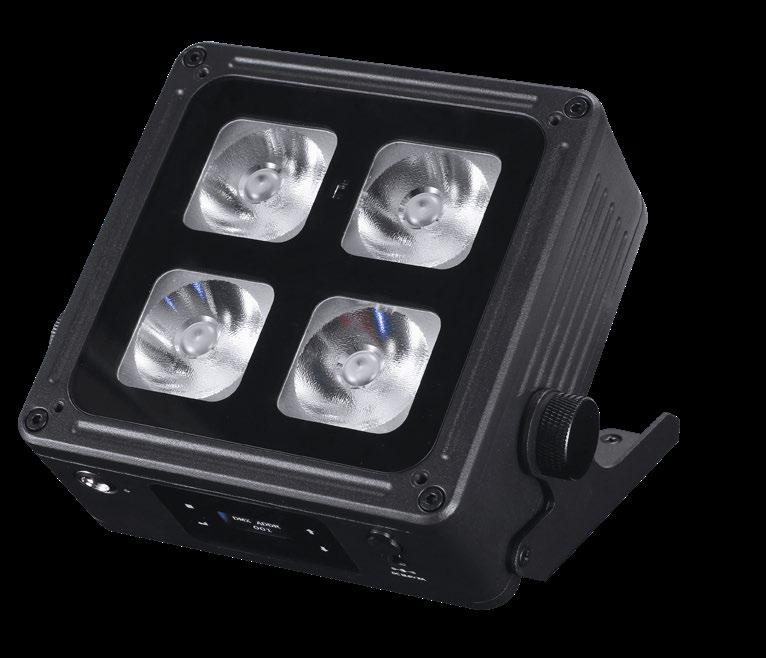

AlphaTheta has introduced the HDJ-F10 professional wireless DJ headphones. With SonicLink wireless technology, the headphones feature ultra-low latency. When using the HDJ-F10 headphones with the SonicLink HP-TX01 transmitter, DJs enjoy freedom from cables, allowing them to energize the crowd by dancing and moving around the DJ booth or stage without ever tangling or pulling on a wire. Featuring a new driver design, the HDJ-F10 produces high-resolution, powerful sound with a wide range. The headphones include enhanced earpads, housing structures and sound insulation. DJs can sync the headphones to a mobile phone or other Bluetooth-capable devices. Using the Noise Cancelling mode, DJs can immerse themselves in the music as if they are checking the sound of each track in the studio. The HDJ-F10 is available on its own, or as part of the HDJ-F10-TX bundle which includes the HP-TX01 transmitter.
AlphaTheta Corporation 2050 W 190th St #109 Torrance, CA 90504 (424) 488-0480 www.alphatheta.com
JMAZ Lighting has introduced the MAD PAR 4IP, a versatile, battery-powered outdoor uplight. The unit is equipped with four 15-watt RGBWA+UV LEDs, delivering 60 watts of dynamic lighting. Designed for durability, the IP65-rated die-cast aluminum and steel structure ensures reliable performance in any weather. Its features include: 64 preset color programs with an advanced sound-active mode; a focused 10-degree beam angle; 14 hourse of battery life and a quick four-hour changing time; and wireless DMX and an IR remote for seamless control. Ideal for events, architectural lighting, and more, the MAD PAR 4IP combines quality and convenience in a sleek black finish.
JMAZ Lighting 2422 Lee Ave S. El Monte, CA, 91733 (626) 380-0883 www.JMAZlighting.com
On-Stage has released the SMS7500W wood studio monitor stands, which hold heavy monitor speakers in an optimal position for mixing, mastering and playback. Each stand sturdily supports a monitor speaker weighing up to 90 pounds. Nonslip padding on the speaker platforms prevents skidding or sliding to keep speakers safely in place, dampens vibrations to maintain natural sound, and protects cabinets from scratches. The wide, flat bases with rubber feet deliver outstanding stability and balance. The stand height adjusts to enable precise speaker placement in a variety of spaces. With a height range of 35.5 to 56.5 inches, the speakers can be placed at a level that accommodates listening in seated or standing setups. Newly available in white, the stands also come in black and rosewood finishes, delivering a refined, furniture-like presentation that enhances the appearance of any recording studio or listening space.
On-Stage/The Music People 154 Woodlawn Rd Berlin, CT (800) 289-8889 www.on-stage.com
ADJ has released the WMX1 MK2, an upgraded version of the stand alone DMX lighting controller with more than 15,000 fixture profi Like its predecessor, the unit is designed to create high-impact light shows on the fly without a computer. The new unit intro duces user-inspired enhancements while continuing the tradition with an intuitive workflow, powerful internal FX engine, and tactile controls. These features make it simple for anyone to command a DMX lighting rig with multiple fixture types from different brands. WMX1 MK2 upgrades include four larger encoder caps for a more tactile feel, MIDI triggering, and an added USB-A socket to link with MIDI faders and sync with MIDI clock, or to insert a memory stick to backup projects and fixtures.
ADJ 6122 S. Eastern Ave Los Angeles, CA 90040 (323) 316-9722 www.adj.com


Yorkville Sound has released a pair of updated entries to its NX series of powered loudspeakers – the NX8P and NX12P. The two systems offer advanced DSP, powerful limiting, and extended connectivity. The NX8P features an 8-inch woofer and 2,600 watts of peak power (1,000 watts program) – it’s now the most compact, portable speaker in the NX series. The NXP12 features a 12-inch woofer and 4,850 watts of peak power (1,450 watts program). In addition to the main XLR input and output, the updated NX units each have an onboard three-channel mixer, so it doesn’t require an external console for small PA applications. Two mono channels each feature Combi-Jack inputs, phantom power, switchable mic or line input levels, and switchable high-pass filters. The third channel accepts stereo 1/8-inch line or Bluetooth sources, including wireless stereo playback between two cabinets.
Yorkville Sound USA 4625 Witmer Industrial Estates Niagara Falls, NY 14305 (716) 297-2920 www.yorkville.com
Native Instruments has released the biggest update ever to its flagship production suite, Komplete 15. The update introduces over 50 newly included instruments, effects, and expansions, providing an unparalleled range of creative tools to take productions from start to finish. Komplete 15 comes in four versions: Select, Standard, Ultimate, and Collector’s Edition. Highlights include Kontakt 8, the latest version of N.I.’s sample-based instrument platform, which introduces new Chords and Phrases Tools – Leap, a looping tool, and Conflux, a hybrid instrument with enhanced wavetable features that allows users to modulate organic and synth-based sounds in real-time. Kontakt 8 is included in Komplete 15 Standard, Ultimate, and Collector’s Edition.
Native Instruments North America
5101 Santa Monica Blvd Ste 8 Los Angeles, CA 90029 (866) 556-6487 www.native-instruments.com

Roland has released the P-6 Creative Sampler, the latest addition to it growing AIRA Compact family of portable instruments. The unit includes granular sound-design tools, sequencing, real-time effects, onboard mic, intuitive controls, a USB-C audio/MIDI interface, and a versatile selection of hands-on MFX. Whether using the built-in mic, analog inputs, or a smartphone via USB-C, the P-6 is ready to sample at a moment’s notice. After capturing sounds, it’s easy to chop up longer samples for triggering from the onboard keyboard or combine multiple sounds with Step Sampling and resampling features. There’s also a curated selection of hands-on MFX, including Vinyl Simulator, DJFX Looper, Stopper, Lo-fi, Scatter, Phaser, Resonator, and more. Roland 5100 S. Eastern Ave. Los Angeles, CA 90040 (323) 890-3700 www.roland.

Lighting-control software SoundSwitch has released version 2.9 of its flagship software. Known for its ability to create automatic, beatsynced light shows for popular DJ software like Serato, Virtual DJ, and Engine DJ, SoundSwitch is now expanding its capabilities with the introduction of Auto BPM Detection. This latest feature allows users to sync lighting with any audio source, making it an indispensable tool for DJs using unsupported software, live bands, and venues with mixed audio setups. The new BPM Detection feature allows users to connect any audio source to SoundSwitch. The software will detect the BPM in real-time and use it for Autoloops playback, enabling seamless syncing of lighting with audio from DJ software not currently supported by SoundSwitch or streaming services like Spotify.
SoundSwitch/inMusic 200 Scenic View Dr. Cumberland, R.I., 02864 (401) 658-3131 www.soundswitch.com
England’s Solid State Logic, distributed stateside by Group One Limited, has introduced the SSL 2 MKII and SSL 2+ MKII audio interfaces. Both units feature elevated performance and enhanced features compared to the original models. SSL 2 MK II is perfect for individual artists and media creators, while the SSL 2+ MKII offers expanded I/O for musicians and producers working and recording together. Key features include: USB-C bus-powered audio interface compatible with Mac/PC; 2-in/2-out for SSL 2 MKII and

2-in/4-out for SSL2+ MKII; Next-Gen 32-bit 192 kHz converters delivering 120 dB dynamic range; two SSL mic preamps with dedicated high-pass filter, line-input, and 48V phantom power; two auto-detect instrument (DI) inputs; and two professional high-current headphone outputs (SSL 2 MKII same mix/SSL 2+ MKII independent mix).
SSL/Group One Ltd. 70 Sea Lane Farmingdale, NY 11735 (631) 396-0195 www.solidstatelogic.com



M-Audio has released its Forty Series of studio monitors. Including the Forty Sixty and the Forty Eighty models, the range offers Bluetooth 5.0 streaming and DSP-powered sound customization. Other key features include
Pro-grade A/D converters for superior sound quality with low noise and signal accuracy and front-panel instant listening modes so that users can switch between Flat for reference monitoring, Hype for consumerstyle enhanced listening, and Custom EQ for personalized audio profiles. The Forty Sixty unit, ideal for smaller studios, features a 6.5-inch woofer, a one-inch frequency driver, and 100-watt amplification. Perfect for larger spaces with more demanding audio projects, the Forty Eighty features an 8-inch woofer, a .25-inch frequency driver, and 150-watt amplification.
M-Audio/inMusic 200 Scenic View Dr. Cumberland, R.I., 02864 (401) 658-3131 www.m-audio.com

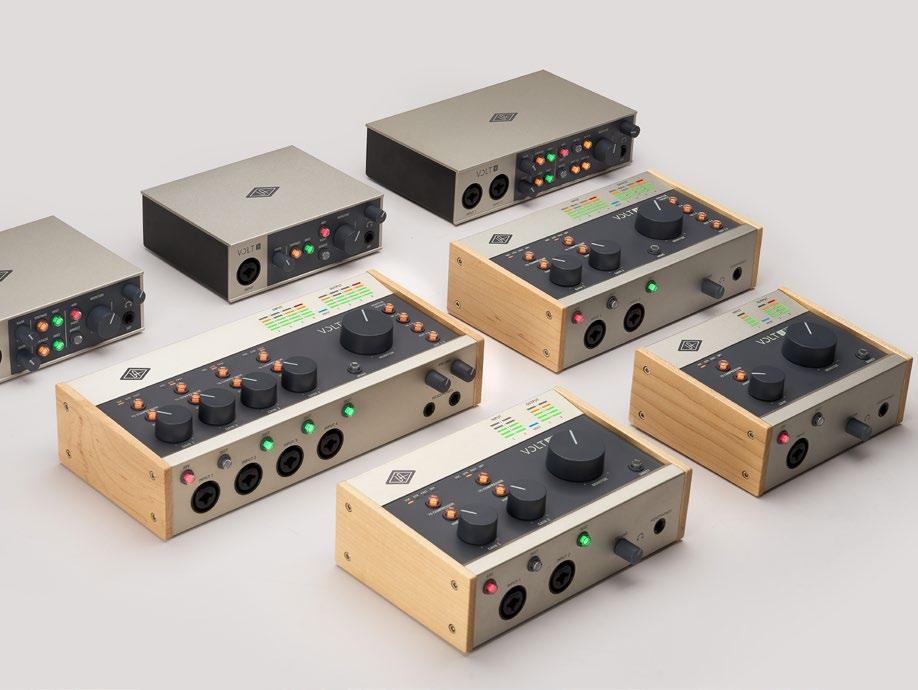
England’s Decksaver, distributed Stateside by Mixware, has released a flood of new protective covers for DJ, music and creative gear, bringing its total range to 450 covers. For DJs, the release includes polycarbonate covers for newer DJ products like AlphaTheta’s euphonia rotary 4-channel mixer, Headliner’s R4 4-pot rotary mixer, the wireless Phase DJ Essential controller, and Rane’s Performer 4-channel controller. For producers, covers are available for AKAI’s MPC Key 37 and MPK Mini Plus controllers, Din Sync’s RE303 bassline machine, Oxi Instruments’ Oxi One, and Nektar’s Panorama CS12. For synth users, covers are available for Korg’s KingKorg Neo and KAOSS Replay, Sequential’s TRIGON-6 and Oberheim’s OBX-8. Decksaver/Mixware
11070 Fleetwood St., Unit F Sun Valley, CA 91352 (818) 578-4030 www.decksaver.com
Universal Audio has released its Volt USB Recording Studio, which includes USB audio interfaces with LUNA DAW and UAD plug-in bundle. Entry-level interfaces for the range include Volt 1 (1 preamp, 1-in/1-out); Volt 2 (2 preamps, 2-in/2-out); and Volt 3 (2 preamps, 4-in/4-out). For musicians and podcasters, interfaces include Volt 176 (Vintage Mode, 76 Compressor, 1-in/2-out); Volt 276 (Vintage Mode, 76 Compressor, 2-in/2-out); and Volt 476 (Vintage Mode, 76 Compressor, 4-in/4-out). For recording engineers and bands, there’s the Volt 476P ((Vintage Mode, 76 Compressor, 4-in/4-out and two HP outputs). Third-party software bundles include Ableton Live Lite; Melodyne Essential by Celemony; and BX Masterdesk Classic.
Universal Audio, Inc. 4585 Scotts Valley Drive Scotts Valley, CA 95066 (831) 440-1176 www.uaudio.com






“Ain’t Nothing Going On”
Gianni Bini & Anduze Groove Culture
There is simply no stopping the Groove Culture label, as almost every single release is outstanding. Here we have Gianni Bini providing the backbone of a great house/disco workout, supplemented by label owners Micky More and Andy Tee on the remix. Pure, pure quality
– Curtis Zack Diplo



“Time”
Tommy Glasses Fool’s Paradise
Doing damage in all the right places, and already up 20 releases, Fool’s Paradise returns this time featuring French disco don, Tommy Glasses. Disco synths and an understated vocal combine sublimely for what is another essential release.
– Curtis Zack
“Thinking About You” (Remixes)
Random Soul
Random Soul Records
Disco-licious Aussie Dr. Packer is truly on remix fire with Random Soul’s latest groover. So burn, baby, burn! He adds signature boogie-down synthy key jabs, perfectly placed hand claps, and a low-down funky baseline to accompany Yogi’s upbeat soulful vocal to bring everything together valiantly. With his remix, fellow countryman and producer Jay Bhana takes it a little deeper and more luscious, but no less effective.
– Joe Berinato
“Forever”
HUGEL & Diplo (feat. Malou & Yuna) Insomniac
Hot on the heels of “I Adore You,” the past summer’s top tune, French producer HUGEL teams up with the colossal Diplo and singers Malou & Yuna to create a followup tour de force. Its big-room synths and chunky 120-BPM Afro-rave rhythms are the perfect bed for those sweet aching vocals to lay seductively on top. At only 2:27 in length, a repeat play is a must.
– Joe Berinato
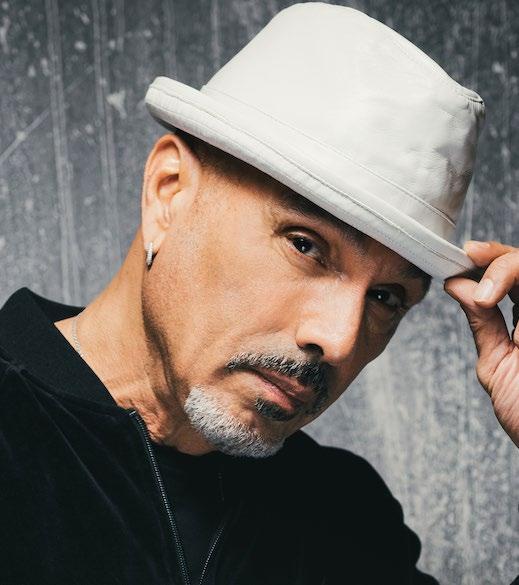
“Celebrate”
David Morales Diridim

The legend that is Mr. Morales is back with a feelgood gospel workout, especially made for some serious booty-shaking. As you’d expect, the production is outstanding, and with an all-star line-up of vocalists (Antoinette Dunleavy, Bryan Chambers, Maria Quintile, Romina Johnson and Elle Cato), this is a single to definitely celebrate.
– Curtis Zack
“Weekend Release”
Janika Tenn, Todd Terry & Tristan Henry
D4 D4ANCE
A real dancefloor rouser, this collab between the house legend Terry, Estonian DJ/producer Tenn and vocalist Henry hails the end of the work week with plenty of flair. Upbeat, hands-inthe air, perfect for Friday and Saturday nights.
– Jim Tremayne


“Delight” EP (Remixes)
Christian Burkhardt CB Sessions
Franco Cinelli, Arno & DJ Dope, and many more revisit one of Christian Burkhardt’s biggest house hits, “Delight.” Check Cinelli’s remix if you’re looking for a funky, subby groover to warm things up. Arno & DJ Dope drop an off-kilter breakbeat mix guaranteed to make the entire club shake it. The original mix and other strong remixes from Mihai Popoviciu, Señor Gaga and Dan B aren’t to be skipped either.
– Chris Davis
“Mine”
Audiowhores feat. Nikara Midnight Riot
Returning to their soulful roots, the Audiowhores team up with vocalist Nikara for this bumpin’, disco-flavored cut. Featuring a stack of live musicianship and quality production, this is everything you would expect from the Manchester duo.
– Curtis Zack
“So Good” Tenacious
Fool’s Paradise Fool’s Paradise, Toolroom’s sister label, delivers a hot one here from U.K. trio Tenacious. They offer a straight-forward house track with full rolling conga percussion, building basslines, and a perfect feelgood hook. The key to this track lies in its simplicity, as it fuels the floor with its positive energy. So good is right!
– Joe Berinato
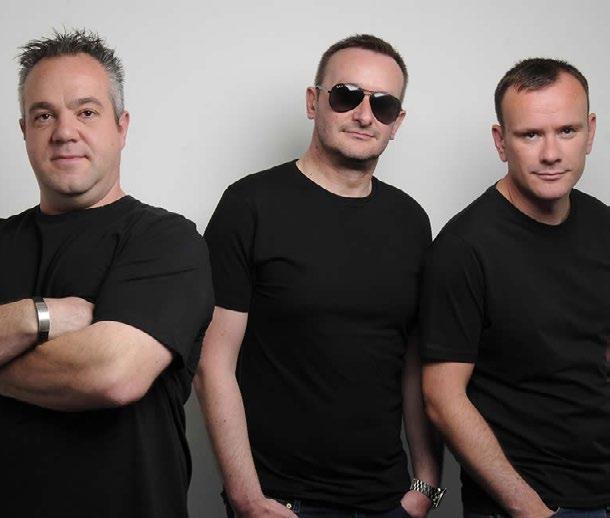
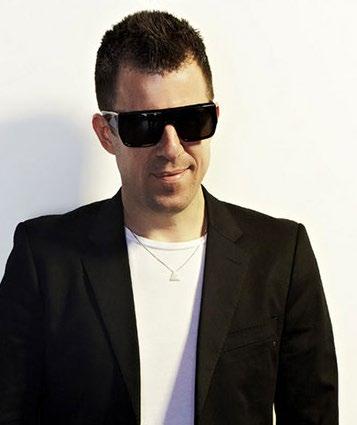
“Dance With You” Sgt Slick feat. Karina Chavez Vicious
On his latest groove-fest, Sgt Slick takes on the 1979 Carrie Lucas classic Dance with You, which is better known on house floors as the track Armand Van Helden sampled for his 1998 hit “You Don’t Know Me.” This one sticks pretty true to the original, but beefs up the drums and naturally has that housier vibe. For a bigger bump, check the “JARC Remix.”
– Curtis Zack



■ Gary Canavo masspooldjs Saugus,MA
■ DJ Sticky Boots The HyperMiXx Syndicated
■ Dan Mathews Rhythm 105.9FM + Syndicated
■ Manny Esparza Nexus Radio Chicago,IL
■ Howard HK Kessler In The Mix With HK Syndicated
■ Randy Schlager KNHC 89.5FM Seattle, WA
■ DJ Ilan Fong Multiple Pod Casts Columbus, OH
■ Chris Egner Victors Milwaukee, WI
■ Alan Chasen OMAP Washington, D.C.
■ Steve Tsepelis Pacific Coast Long Beach, CA
■ Brian Stephens Mixxmasters Lithonia,GA
■ Peter K. Productions Peter K Syndicated
■ DJ Spawn Mix 93 FM
■ Michael Cerchiai
■ Ritmo Internacional Record pool
■ DJ Latinos Record Pool
■ MassPool
■ Record Pool Latino
■ Latin Beat Chicago Record Pool
■ All In Music Pool
